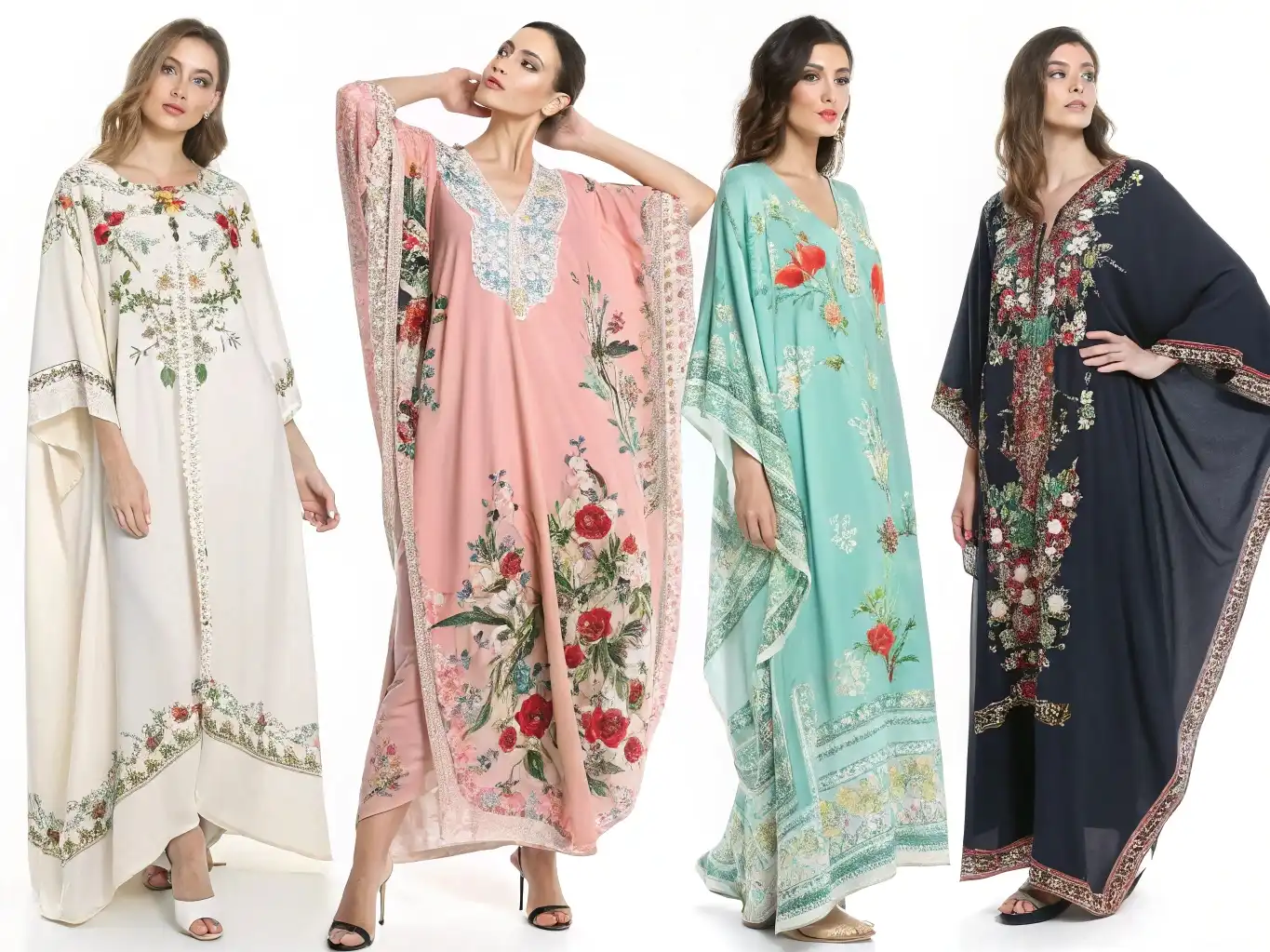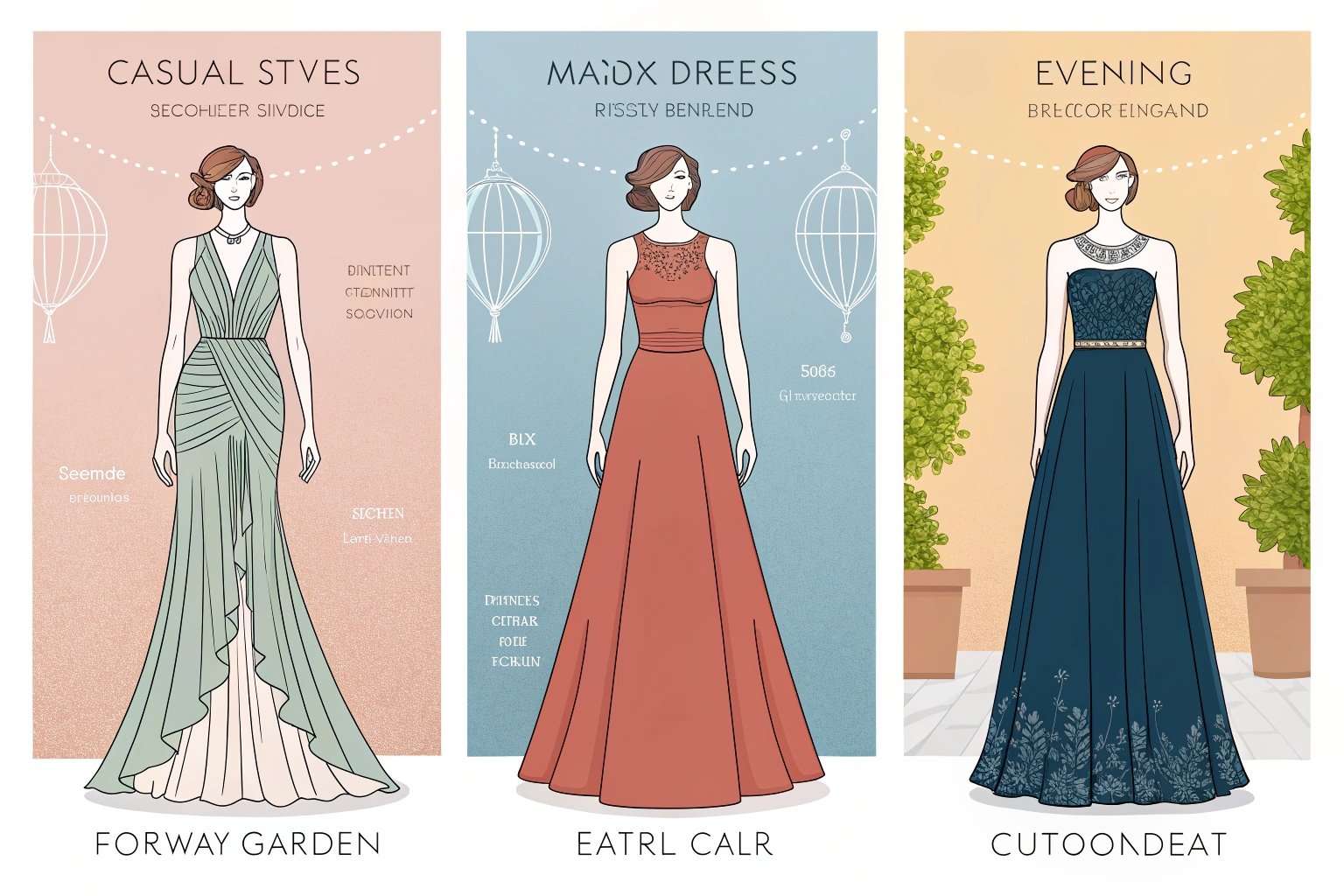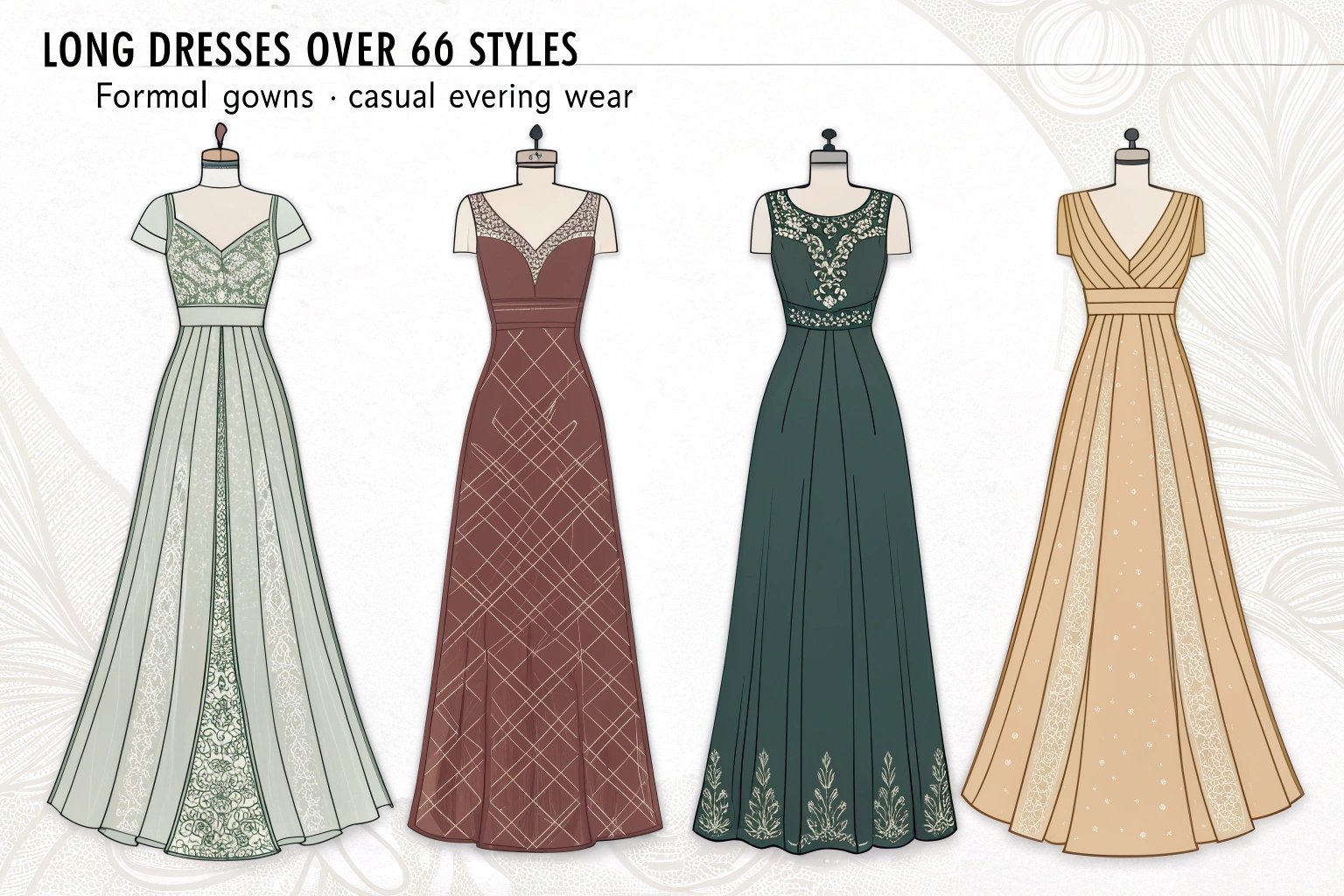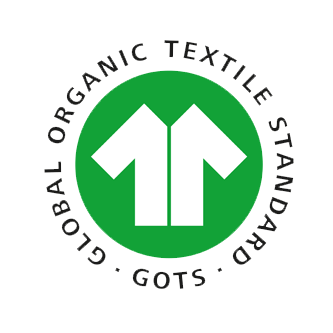In the first two installments of our Types of Dresses series, we laid the foundation for understanding one of the most iconic and versatile categories in women’s fashion. Part 1 introduced the key silhouettes, lengths, and construction features behind over 80 core dress types—helping readers distinguish each style with clarity and purpose. Part 2 expanded on this knowledge by exploring fabric compatibility, seasonal use, and the production implications of different dress types.
Now, in Part 3, we shift focus to the strategic application of dress styles—examining how specific cuts complement different body shapes, how cultural and climate factors influence dress trends, and how brands can tailor their offerings by market region. This chapter is essential for fashion professionals aiming to go beyond aesthetics and develop truly market-ready collections that fit real-world needs. By the end, you’ll be able to connect dress design with customer behavior, regional styling logic, and retail performance.
Prom Dress
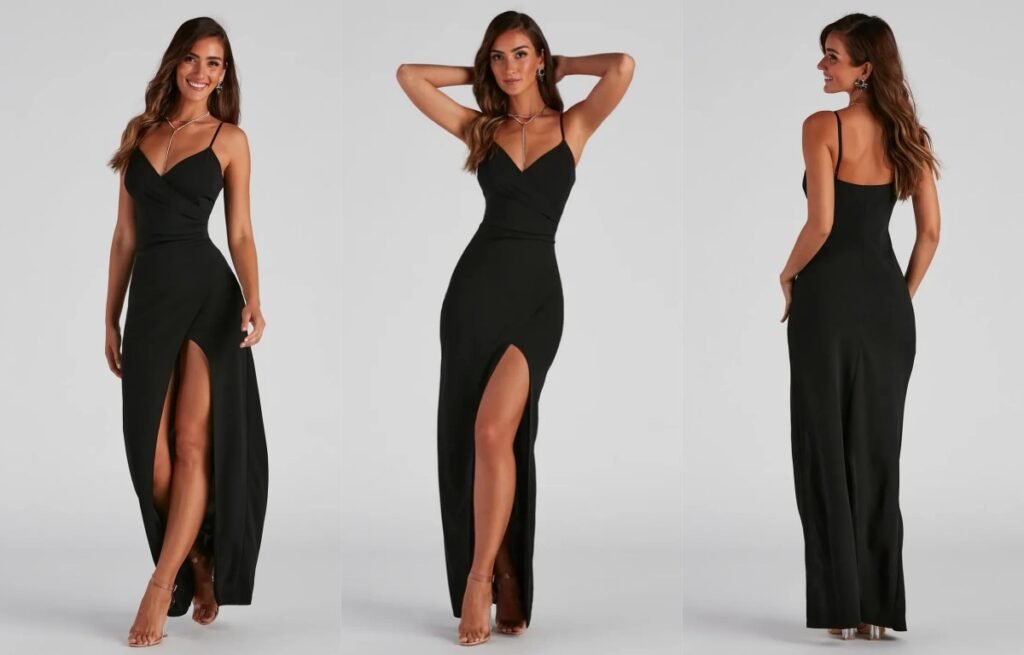
Prom Dress: The Dress That Defines a Moment
A prom dress is more than just a gown—it marks one of the most important events in a young woman’s life.
Typically formal and elegant, prom dresses come in various silhouettes like A-line, mermaid, ball gown, or fitted styles, often made from luxurious fabrics with standout details. It’s a once-in-a-lifetime fashion moment tied closely to personal identity and youth culture.
Why is the prom dress such a powerful fashion symbol?
A prom dress isn’t just about style—it’s about self-expression, confidence, and creating a memorable first step into adulthood.
Prom dresses reflect a teen’s personality, social identity, and fashion taste—all while capturing a significant life milestone. The right design empowers the wearer and creates lasting emotional value.
The Cultural and Design Depth Behind Prom Dresses
The prom dress might look like a glamorous evening gown, but there’s more beneath the surface. Let’s break down why it matters and what makes it a meaningful fashion category.
A Rite of Passage in Western Culture
In many Western countries, prom is one of the first formal events young women attend. It symbolizes the transition from high school into adulthood. The dress becomes more than fabric—it becomes a memory, often saved, photographed, and shared for years.
- Emotional attachment: Prom dresses often carry emotional weight, chosen with care and anticipation.
- Cultural moments: Social media, celebrity influence, and red-carpet trends all shape how prom dresses evolve.
A Showcase of Style Identity
Prom night is one of the first opportunities where young women express their fashion identity without school uniforms or dress codes. The choice of silhouette, fabric, and styling all speak to:
- Personality: Bold, romantic, minimal, edgy, classic
- Confidence level: Some prefer understated satin; others go full sparkle
- Trend alignment: Prom dresses often mirror current fashion trends, especially in cut-outs, slits, sleeves, or colors.
Variety in Silhouettes and Fabrics
Prom dresses are incredibly diverse. Here are a few common styles:
| Style | Features | Best For |
|---|---|---|
| A-Line | Fitted top, flared skirt | Universally flattering |
| Ball Gown | Full skirt, dramatic silhouette | Petite or formal elegance |
| Mermaid | Fitted through hips, flares below | Hourglass or confident figures |
| Slip Dress | Sleek, minimalist | Tall or lean body shapes |
Popular fabrics include satin, tulle, chiffon, lace, velvet, and organza—often with embellishments like sequins, rhinestones, appliqué, or embroidery.
Balancing Comfort and Drama
While prom dresses are all about impact, comfort still matters. Many modern designs include stretch linings, adjustable straps, or hidden zippers to make the night enjoyable without sacrificing the look.
Influence of Social Media and Global Trends
Instagram, Pinterest, and TikTok now heavily influence prom dress decisions. Viral dress trends can sell out globally, and girls often look for designs that feel “Pinterest-worthy” or red-carpet inspired. Customization and personal styling are becoming more common—even with off-the-rack dresses.
Styling Tips for Prom Dresses
- Shoes: Choose heels that match the dress but are also wearable all night.
- Accessories: Balance is key—go bold on either earrings or necklace, not both.
- Hair: Match the neckline. Updos for high necks, waves for strapless styles.
- Bag: Small clutch in a complementary tone—metallics work well for most looks.
Bridesmaid Dress
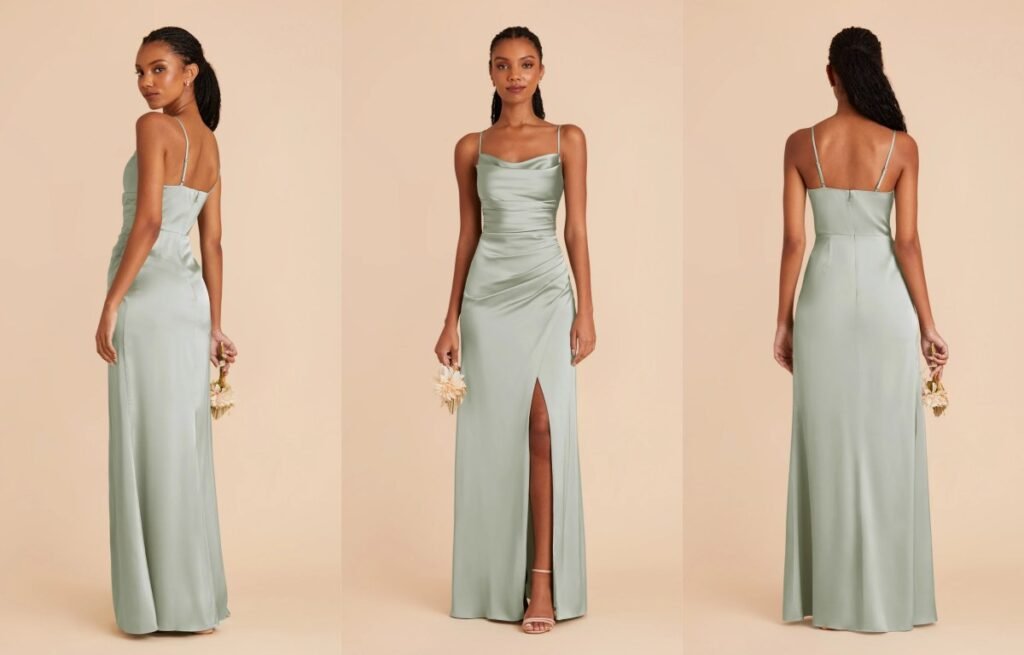
Prom Dress: The Dress That Defines a Moment
A prom dress is more than just a gown—it marks one of the most important events in a young woman’s life.
Typically formal and elegant, prom dresses come in various silhouettes like A-line, mermaid, ball gown, or fitted styles, often made from luxurious fabrics with standout details. It’s a once-in-a-lifetime fashion moment tied closely to personal identity and youth culture.
I’ve seen clients spend weeks deciding on their perfect prom look—it’s emotional, personal, and often a defining memory of their style journey.
Why is the prom dress such a powerful fashion symbol?
A prom dress isn’t just about style—it’s about self-expression, confidence, and creating a memorable first step into adulthood.
Prom dresses reflect a teen’s personality, social identity, and fashion taste—all while capturing a significant life milestone. The right design empowers the wearer and creates lasting emotional value.
The Cultural and Design Depth Behind Prom Dresses
The prom dress might look like a glamorous evening gown, but there’s more beneath the surface. Let’s break down why it matters and what makes it a meaningful fashion category.
A Rite of Passage in Western Culture
In many Western countries, prom is one of the first formal events young women attend. It symbolizes the transition from high school into adulthood. The dress becomes more than fabric—it becomes a memory, often saved, photographed, and shared for years.
- Emotional attachment: Prom dresses often carry emotional weight, chosen with care and anticipation.
- Cultural moments: Social media, celebrity influence, and red-carpet trends all shape how prom dresses evolve.
A Showcase of Style Identity
Prom night is one of the first opportunities where young women express their fashion identity without school uniforms or dress codes. The choice of silhouette, fabric, and styling all speak to:
- Personality: Bold, romantic, minimal, edgy, classic
- Confidence level: Some prefer understated satin; others go full sparkle
- Trend alignment: Prom dresses often mirror current fashion trends, especially in cut-outs, slits, sleeves, or colors.
Variety in Silhouettes and Fabrics
Prom dresses are incredibly diverse. Here are a few common styles:
| Style | Features | Best For |
|---|---|---|
| A-Line | Fitted top, flared skirt | Universally flattering |
| Ball Gown | Full skirt, dramatic silhouette | Petite or formal elegance |
| Mermaid | Fitted through hips, flares below | Hourglass or confident figures |
| Slip Dress | Sleek, minimalist | Tall or lean body shapes |
Popular fabrics include satin, tulle, chiffon, lace, velvet, and organza—often with embellishments like sequins, rhinestones, appliqué, or embroidery.
Balancing Comfort and Drama
While prom dresses are all about impact, comfort still matters. Many modern designs include stretch linings, adjustable straps, or hidden zippers to make the night enjoyable without sacrificing the look.
Influence of Social Media and Global Trends
Instagram, Pinterest, and TikTok now heavily influence prom dress decisions. Viral dress trends can sell out globally, and girls often look for designs that feel “Pinterest-worthy” or red-carpet inspired. Customization and personal styling are becoming more common—even with off-the-rack dresses.
Styling Tips for Prom Dresses
- Shoes: Choose heels that match the dress but are also wearable all night.
- Accessories: Balance is key—go bold on either earrings or necklace, not both.
- Hair: Match the neckline. Updos for high necks, waves for strapless styles.
- Bag: Small clutch in a complementary tone—metallics work well for most looks.
Bridal Dress
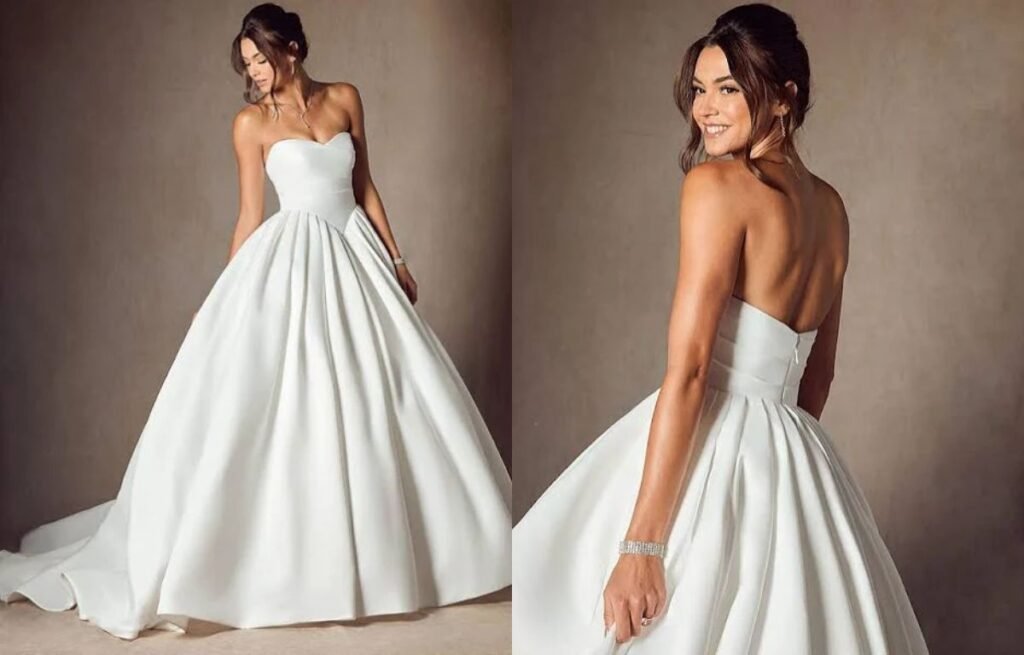
Bridal Dress: The Ultimate Symbol of Style and Tradition
The bridal dress is more than just clothing—it’s a statement of personal taste, culture, and celebration.
A bridal dress is traditionally worn during a wedding ceremony and often features luxurious fabrics, detailed craftsmanship, and silhouette-enhancing cuts. It’s one of the most symbolic and emotional fashion pieces a woman will ever wear.
What makes a bridal dress truly iconic?
A bridal dress is defined not just by design but by the meaning it carries.
It combines aesthetics, fit, tradition, and emotion to reflect both the bride’s personality and the ceremony’s tone. From minimalist slip dresses to dramatic ball gowns, bridal styles are deeply personal yet culturally influenced.
Understanding the Layers Behind the Bridal Dress
A bridal dress isn’t just about beauty—it’s about how design, emotion, and purpose intersect.
1. Silhouettes That Define the Bride’s Look
Choosing the right silhouette is key to flattering the body and setting the tone. Each shape carries its own personality:
- A-line: Universally flattering, classic elegance
- Ball gown: Regal, dramatic volume
- Mermaid: Sexy, body-hugging
- Sheath: Sleek, minimalist
- Empire: Romantic, high-waist vintage feel
Each silhouette works differently across body types and wedding themes.
2. Fabric and Texture Set the Mood
Fabrics do more than add style—they define the movement and feel of the gown:
| Fabric | Effect | Ideal For |
|---|---|---|
| Satin | Smooth, luxurious | Formal evening weddings |
| Lace | Romantic, detailed | Garden or vintage ceremonies |
| Tulle | Airy, voluminous | Dramatic silhouettes |
| Chiffon | Light, flowy | Beach or destination weddings |
| Mikado | Structured, minimal | Modern, clean designs |
Layering, embroidery, or beading adds complexity and emotion to the fabric.
3. Neckline and Sleeve Choices Matter
- Sweetheart neckline: Romantic and feminine
- Off-shoulder: Soft and elegant
- High-neck: Regal and modest
- Sleeveless: Classic and modern
- Long sleeve: Formal, timeless, or religious-appropriate
These elements shape not just the gown’s appearance but also how the bride feels in it.
A growing number of modern brides now seek:
- Convertible designs (with detachable trains or overskirts)
- Sustainable fabrics
- Custom-made gowns to reflect heritage or unique stories
4. Bridal Dress vs. Other Formal Dresses
| Feature | Bridal Dress | Evening Gown |
|---|---|---|
| Symbolism | High (ceremonial, cultural) | Moderate (event-based) |
| Design Detail | Extensive (train, veil, etc.) | Varies |
| Fabric Choices | Rich, layered | Elegant, simpler |
| Emotional Value | Very high | Occasional |
Best Styling Elements for a Bridal Dress
- Veils and trains: Add drama and tradition
- Jewelry: Keep minimal or symbolic
- Shoes: Comfort meets elegance—often unseen but essential
- Hair and makeup: Should match the mood of the dress
Maternity Dress
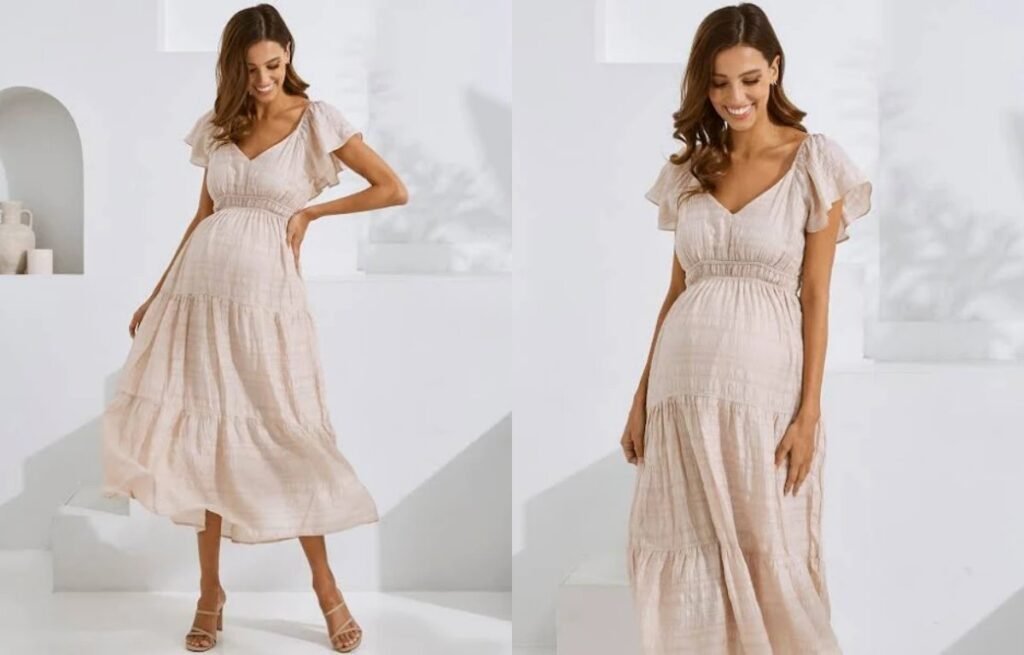
Maternity Dress: Designed for Comfort, Built for Change
The maternity dress is specially designed to support a woman’s body throughout pregnancy, adapting to her changing shape without sacrificing style.
It offers extra room around the belly, stretchy materials, and thoughtful design elements like empire waists, wrap fronts, or ruching. Maternity dresses are essential for comfort and confidence during all stages of pregnancy.
What makes a maternity dress different from regular dresses?
The difference lies in how the garment grows with the body.
Maternity dresses use flexible fabrics, smart silhouettes, and comfort-focused cuts to accommodate a growing belly. They’re not oversized versions of regular dresses—they’re engineered for support, mobility, and breathability.
The Design Science Behind Maternity Dresses
Maternity fashion may look simple, but good design in this category requires technical precision and deep understanding of body changes during pregnancy.
Key Design Elements
- Empire Waistlines
This silhouette places the waist just below the bust, allowing fabric to flow over the belly without restriction. It flatters the figure and creates a balanced profile. - Stretch Fabrics
Most maternity dresses use spandex-blended knits like cotton jersey, modal, or rayon blends. These fabrics allow flexibility and shape retention throughout different pregnancy stages. - Ruching and Pleats
Ruching along the side seams or pleats at the waistline offer room for expansion and help the dress fit snugly but comfortably, especially from the second trimester onward. - Wrap and A-Line Cuts
Wrap dresses provide easy adjustability and often double as nursing-friendly pieces. A-line silhouettes provide comfort without clinging to the body. - Breathability and Softness
Hormonal changes during pregnancy increase sensitivity to heat and fabric texture. Maternity dresses must prioritize softness and breathability to avoid skin irritation.
How Maternity Dresses Adapt Over Time
| Feature | Early Pregnancy | Mid Pregnancy | Late Pregnancy |
|---|---|---|---|
| Fabric Stretch | Light shaping | Medium flexibility | Full belly coverage |
| Silhouette | Regular fit with room | Empire or ruched style | Wrap or maxi dresses |
| Support Needs | Minimal | Belly support needed | Maximum stretch & comfort |
Function Meets Fashion
Modern maternity dresses aren’t just practical—they’re stylish, too. Many brands now offer trend-forward designs with:
- Puff sleeves
- Bold prints
- Ruffle details
- Tiered skirts
- Adjustable ties
These keep moms-to-be feeling confident, not just comfortable.
Postpartum Wearability
Another important feature is post-pregnancy usability. Well-designed maternity dresses often double as nursing dresses, featuring:
- Hidden zippers
- Button-fronts
- Cross-over necklines
This dual functionality adds long-term value to the garment.
Best Fabrics for Maternity Dresses
- Cotton Jersey: Soft, breathable, and stretchy for all-day wear.
- Modal and Bamboo Blends: Lightweight and gentle on sensitive skin.
- Rayon-Spandex Mix: Great for body-hugging yet comfortable fits.
- Knitted Rib Fabric: Adds subtle texture and stretch.
Styling Tips
- Early pregnancy: Style with a belt above the bump to shape the waist.
- Mid to late pregnancy: Choose ruched or empire styles with flat shoes.
- Postpartum: Wrap styles with nursing access are the most practical.
- Accessories: Simple jewelry and soft cardigans keep the look cozy and chic.
Party Dress
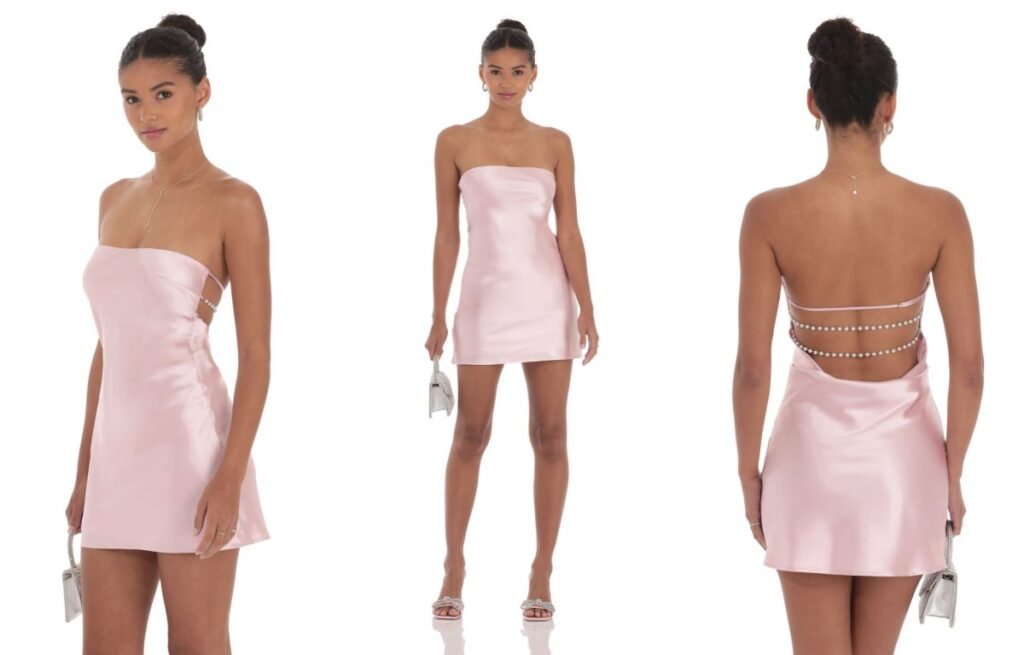
Party Dress: Style That Celebrates Every Occasion
A party dress is designed to stand out—fun, expressive, and made for special moments.
It’s a dress style tailored for events and celebrations, often featuring eye-catching fabrics, bold silhouettes, and fashion-forward details. Whether it’s a birthday, cocktail event, or holiday party, this dress is about making a statement.
What makes a dress a “party dress”?
Party dresses are all about mood—they’re meant to shine, flatter, and feel festive.
It’s not just the shape, but the fabric, color, and styling that define a party dress. Sequins, velvet, satin, bold prints, and creative cuts are all common features.
Understanding the Core of Party Dress Design
Party dresses might look playful, but there’s strategy behind their design. A good party dress balances impact, comfort, and relevance to the occasion. Here’s what makes them special:
Visual Impact
The first rule: a party dress must grab attention. Designers use bold elements like:
- Shimmering textures: Sequins, glitter, metallics
- Playful shapes: Mini skirts, fit-and-flare, or body-hugging cuts
- Unique features: Asymmetrical necklines, cut-outs, feathers, ruffles
These features are crafted to make the wearer feel confident and visually stand out in a crowd.
Occasion Versatility
There’s no one-size-fits-all party dress. Each event has its own tone:
- Cocktail parties: Sleek midi or mini dresses, often bodycon or slip styles
- Formal parties: Long gowns, dramatic fabrics like velvet or silk
- Festive events: Bright colors, sequins, fringe, or sparkle
- Club nights: Shorter hemlines, cut-outs, bold prints, or sheer panels
Designers adjust the level of formality by changing fabric, embellishment, and silhouette.
Comfort & Confidence
It’s not just about looking good—it’s about feeling good while moving, dancing, or socializing. Key features that support comfort:
- Stretch fabrics (jersey, ponte)
- Adjustable straps or open necklines
- Strategic lining to prevent transparency or discomfort
- Zipper or slip-on designs for easy wear
Party Dress vs. Evening Dress
| Feature | Party Dress | Evening Dress |
|---|---|---|
| Occasion | Semi-formal to fun events | Formal, black-tie events |
| Length | Mini to midi | Usually full-length |
| Fabric | Trendy, sparkly, playful | Rich, elegant, often plain |
| Style | Bold, on-trend | Classic, timeless |
Best Fabrics for Party Dresses
- Sequins & Metallics: High-impact, best for night parties
- Velvet & Satin: Adds luxury and texture for winter or formal settings
- Tulle & Chiffon: Creates volume for a playful or flirty effect
- Jersey & Stretch Blends: Fitted and comfortable for dancing
Slip Dress
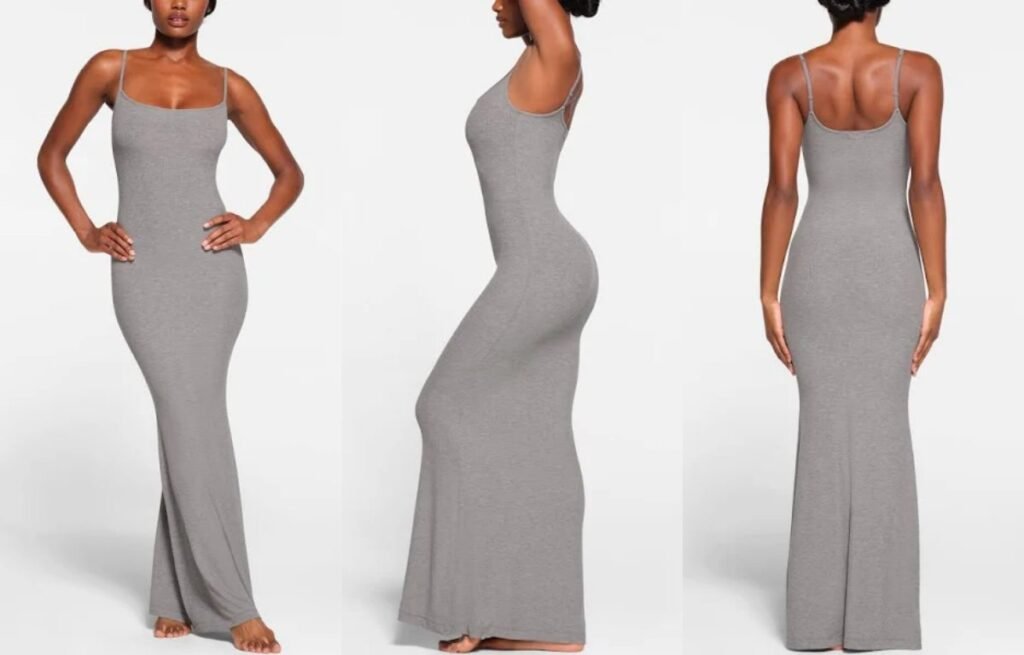
Slip Dress: Effortless, Elegant, and Always in Style
The slip dress is minimal yet iconic, known for its sleek silhouette and lingerie-inspired look.
It typically features thin spaghetti straps, a straight or bias-cut body, and soft, flowing fabric like silk or satin. Originally worn as an undergarment, it’s now a versatile staple in modern wardrobes.
What makes the slip dress so timeless?
Its simplicity is its power. The slip dress can move effortlessly from day to night, casual to formal.
It flatters the body without clinging too tightly, highlighting natural curves through fluid drape and a barely-there feel. With the right styling, it suits nearly every body type and occasion.
Why the Slip Dress Works Across Seasons and Styles
Though minimal in design, the slip dress has depth in its construction, styling potential, and cultural relevance.
The Bias Cut and Body Contour
Most quality slip dresses are cut on the bias—meaning the fabric is cut diagonally across the grain. This allows the dress to softly skim the body, creating movement without tightness. It enhances curves while remaining relaxed and breathable.
- Bias-cut styles move with the body, not against it.
- Straight-cut styles offer a looser, more casual fit.
Versatility in Styling
The slip dress is one of the most adaptable garments in a woman’s closet. Depending on the fabric and accessories, it can transform into different looks:
- Layered over a t-shirt or thin knit for a 90s-inspired daytime look.
- Worn under a blazer or leather jacket for a chic street style.
- Dressed up with heels and jewelry for cocktail or evening events.
- Styled down with sneakers and a denim jacket for everyday casual.
Works Across Seasons
- Spring/Summer: Lightweight fabrics like satin or silk feel cool and breathable.
- Fall/Winter: Style with boots, turtlenecks, or knit layers for warmth.
Slip Dress vs. Similar Styles
| Dress Type | Straps | Fit Type | Typical Fabric | Styling Range |
|---|---|---|---|---|
| Slip Dress | Spaghetti | Bias-cut/slim | Satin, silk | Day to evening |
| Cami Dress | Spaghetti | Straight | Jersey, cotton | Casual, laid-back |
| Bodycon Dress | Varies | Tight-fit | Stretch blends | Party, nightlife |
| Sheath Dress | Wide/narrow | Structured | Woven fabrics | Office, formal |
Body Type Compatibility
Slip dresses suit many body shapes due to their fluid drape:
- Petite: Lengthens the body without bulk.
- Curvy: Highlights the waist and hip lines subtly.
- Athletic: Adds softness and flow to straighter figures.
The key is choosing the right cut and fabric thickness—thicker satin offers more structure, while silk or viscose clings lightly for a sultrier look.
What fabrics work best for a slip dress?
- Silk: Luxurious feel, fluid drape, ideal for evening.
- Satin: Slight sheen, holds shape well, good for both day and night.
- Viscose/Rayon: Lightweight, breathable, more budget-friendly.
- Poly-blends: Great for travel, wrinkle-resistant.
Shirt Dress
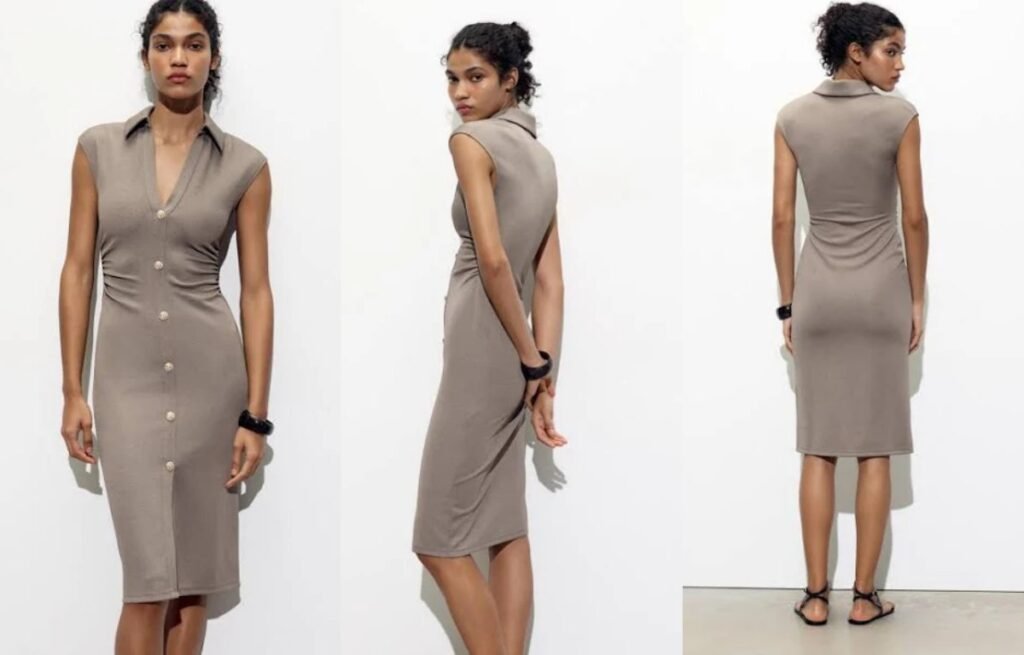
Shirt Dress: Casual Structure with Everyday Appeal
The shirt dress blends the structure of a button-down shirt with the ease of a dress, making it a go-to for effortless style.
It typically features a collar, front buttons, and cuffed sleeves—mirroring a classic shirt—but with added length and feminine tailoring. It’s practical, easy to style, and fits right into both workwear and weekend wardrobes.
Why is the Shirt Dress a Wardrobe Staple?
It’s structured but relaxed, which makes it work in almost any setting.
The shirt dress offers balance: it’s tidy enough for the office, but relaxed enough for casual wear. Its clean lines flatter most body types, and it adapts easily to different fabrics and cuts.
What Makes the Shirt Dress So Versatile?
The shirt dress may look basic, but its design opens up a world of styling and fit options. Here’s why it’s a fashion essential:
Clean Structure Meets Comfort
The shirt dress combines the neat look of menswear-inspired tailoring with the comfort of a loose-fit dress. Its defined collar and button placket give it structure, while the often-loose body provides movement and ease. It’s this mix that makes it ideal for days when you want to look put-together with minimal effort.
Works Across Body Types
- Straight figures: Creates shape with a belt or drawstring waist.
- Curvy bodies: Fitted versions flatter the bust and waistline.
- Petite frames: Shorter hemlines and rolled sleeves give balance.
- Tall silhouettes: Longline shirt dresses elongate even more.
You can adjust shape using belts, buttons, or fabric ties—making it one of the most adaptable dress types.
Fabric = Function
The shirt dress changes character depending on fabric:
- Cotton poplin: Crisp and structured, perfect for work.
- Linen: Lightweight and breezy for summer.
- Denim or chambray: Adds a casual, rugged feel.
- Silk or satin: Creates a dressier, elevated version.
From Office to Off-Duty
One of the key strengths of the shirt dress is its ability to switch roles:
- Office-ready: Pair a tailored shirt dress with loafers or heels.
- Weekend casual: Roll up the sleeves, add sneakers or sandals.
- Layered: Throw on a sweater or jacket, or wear it open over a tank and jeans.
Shirt Dress vs. Other Day Dresses
| Dress Type | Structure | Best For | Vibe |
|---|---|---|---|
| Shirt Dress | Structured, relaxed | Office to weekend | Polished, minimal |
| T-Shirt Dress | Loose, unstructured | Casual wear | Laid-back, simple |
| Wrap Dress | Adjustable waist | Curvier shapes | Feminine, flowy |
| Shift Dress | Boxy silhouette | Straight figures | Mod, easy |
Tunic Dress
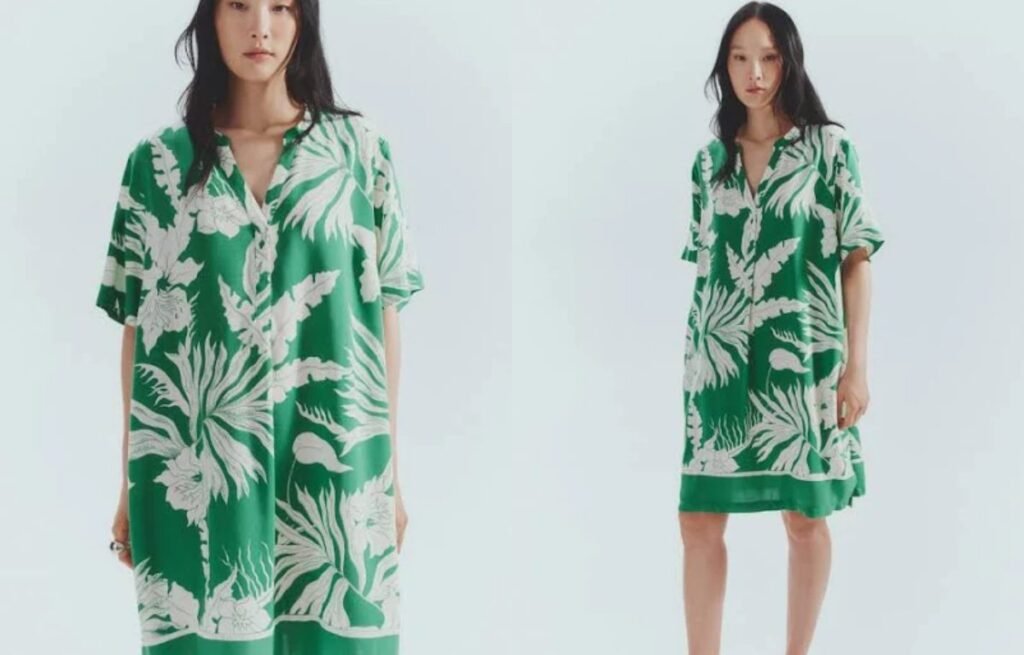
Tunic Dress: Effortless, Versatile, and Always in Style
The tunic dress is a relaxed, easy-to-style silhouette that blends comfort and simplicity.
Tunic dresses are typically straight-cut, fall above the knee or mid-thigh, and often have loose sleeves and minimal shaping. They work well for layering or as standalone pieces, depending on fabric and styling.
I once recommended a tunic dress to a buyer looking for a “one-size-fits-many” solution—her customers loved how easy it was to wear and style.
Why is the Tunic Dress so practical?
The tunic dress is one of the easiest silhouettes to wear across seasons and settings.
It offers comfort, flexibility, and broad body-type compatibility, making it a go-to piece for casual days, workwear layering, or minimalist wardrobes.
Why Tunic Dresses Stand the Test of Time
Tunic dresses may appear basic, but their long-lasting appeal in fashion is tied to several key design and functional elements.
Historical Roots and Modern Relevance
The tunic silhouette dates back centuries, worn by both men and women in various ancient cultures. Its simplicity, straight lines, and unstructured form made it easy to produce and comfortable to wear. Today, the tunic dress keeps those same qualities while adapting to modern fabrics and styling.
Fit That Flatters Without Clinging
Tunic dresses work especially well for:
- Apple and rectangular body types: The loose shape skims over the midsection without drawing attention to it.
- Petite frames: When worn with leggings or styled as a mini dress, they give a chic, effortless look.
- Plus-size: Offers room and comfort without sacrificing structure or polish.
Unlike fitted dresses, tunics don’t rely on waist definition—they instead focus on flow, comfort, and drape. This makes them ideal for a wide customer base.
Styling Range and Layering Power
Tunic dresses are incredibly adaptable:
- With leggings or jeans: Ideal for transitional weather or modest styling.
- As a beach cover-up: In lighter fabrics like linen or cotton gauze.
- Over turtlenecks or long sleeves: For colder seasons.
- Belted: To define the waist and create shape when desired.
Designers love them for their ability to work across collections and climates.
Dress vs. Top-Length Tunics
Some tunics fall right at the upper thigh, while others lean closer to dress length. Retailers often list both under the same category. The tunic dress specifically should be long enough to be worn alone, or with tights, depending on the styling intent.
Tunic Dress vs. Other Casual Styles
| Style | Structure | Best For | Layering Options |
|---|---|---|---|
| Tunic Dress | Loose, straight | Most body types | Excellent |
| Shirt Dress | More tailored | Office & casual settings | Moderate |
| Shift Dress | Slightly shaped | Straight/athletic builds | Limited |
| T-Shirt Dress | Relaxed, casual | Daily wear | Great with jackets |
Best Fabrics for Tunic Dresses
Fabric choice impacts drape and comfort. Tunic dresses work best with:
- Cotton/Poplin: Crisp and breathable
- Rayon/Viscose: Lightweight with soft drape
- Linen: Ideal for summer with a natural texture
- Knits: For relaxed, stretchy versions
Styling Tips
- Accessories: Add long necklaces or statement earrings to break up the volume.
- Belts: Cinch at the waist for a shapelier look.
- Shoes: Pair with flats, boots, or sandals depending on season and styling.
- Layering: Works well under vests, jackets, or sweaters.
Kaftan Dress
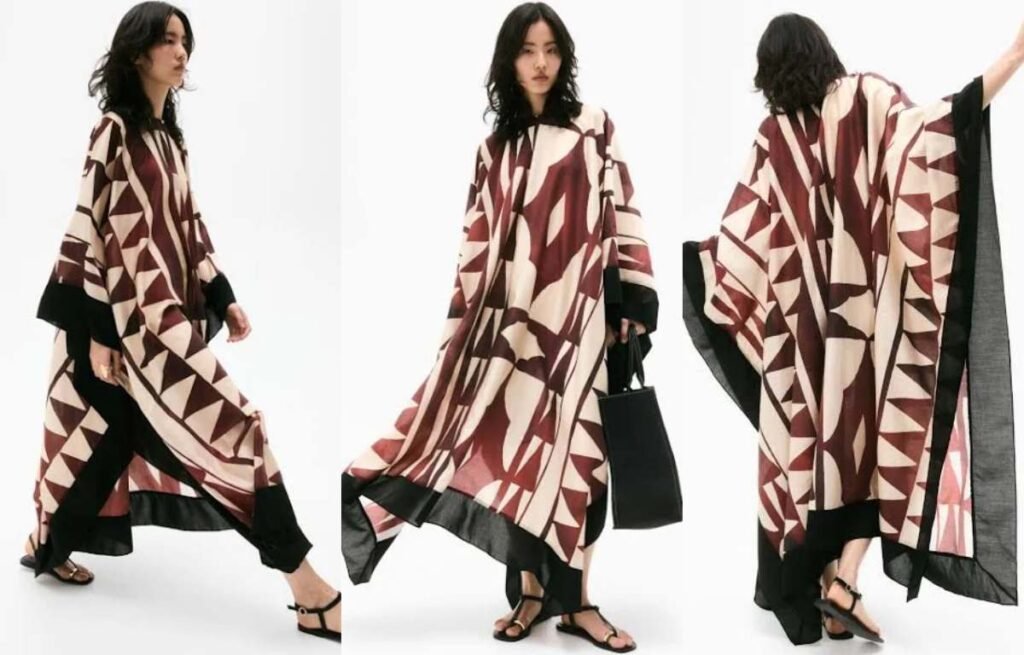
Kaftan Dress: Relaxed Elegance with Global Roots
The kaftan dress is a loose-fitting, flowing garment that combines comfort with effortless elegance.
Traditionally ankle-length with wide sleeves, the kaftan dress drapes freely around the body, making it ideal for hot climates, travel, or relaxed, bohemian-inspired styling. It’s popular for resort wear, loungewear, and even formal occasions when styled right.
I first tried a kaftan dress during a summer trip—its airy feel and easy grace made it my go-to for both day and night looks.
What makes the kaftan dress so versatile?
Its relaxed cut and cultural origins give it a unique presence in both casual and sophisticated wardrobes.
The kaftan’s free silhouette flatters most body types, while its adaptability allows it to shift from beachwear to luxury fashion. It’s one of those rare dress styles where comfort doesn’t compromise style.
Understanding the Kaftan Dress in Fashion Design
Though simple in shape, the kaftan dress holds deep cultural, stylistic, and design relevance:
1. Origin and Evolution
The kaftan originated in the Middle East and North Africa and has historically symbolized both luxury and modesty. Over time, fashion designers across the globe have adapted the silhouette—maintaining the flowing structure but introducing new fabrics, prints, and tailoring techniques.
Today, it bridges traditional wear with modern fashion, often appearing in resort collections, summer edits, and haute couture lines.
2. Comfort-Driven Design
The loose cut and breathable fabric make it ideal for warm weather. Unlike body-hugging dresses, kaftans offer freedom of movement and natural ventilation, which is why they are often used for:
- Resort and beachwear
- Home and loungewear
- Modest fashion collections
- Maternity wear
The design also allows for layering in cooler seasons, often paired with boots or coats.
3. Fabric and Print Flexibility
Kaftan dresses shine in lightweight fabrics like cotton, chiffon, silk, and crepe. The structure is minimal, so much of the visual appeal comes from:
- Prints and embroidery: Floral, tribal, or abstract prints are popular.
- Textiles: From crisp cottons to flowing satins.
- Embellishments: Beading or metallic thread for elevated looks.
4. Body Inclusivity
Kaftans are size-flexible and forgiving. Their non-restrictive shape makes them suitable for all body types, especially:
- Plus-size figures: Comfort and flow without clinging to curves.
- Petite frames: Can create an elongated, graceful line.
- Maternity wear: Offers comfort and room for a growing belly.
5. Styling Range
- Daytime: Pair with flat sandals and natural makeup.
- Evening: Use a belted waist, heels, and statement jewelry.
- Formal events: Choose silk or satin kaftans with metallic accents.
Kaftan vs. Other Loose Dress Styles
| Feature | Kaftan Dress | Maxi Dress | Tunic Dress |
|---|---|---|---|
| Fit | Very loose, flowing | Fitted at top | Shorter, relaxed |
| Length | Ankle or floor | Floor or calf | Mid-thigh to knee |
| Best For | Hot climates, curves | Formal or casual | Everyday wear |
| Common Fabrics | Cotton, silk, chiffon | Jersey, rayon | Linen, cotton |
Best Fabrics for Kaftan Dresses
- Cotton: Breathable, great for daily or beach use.
- Chiffon/Crepe: Lightweight and flowy for resort wear.
- Silk: Luxurious choice for formal or evening kaftans.
- Rayon/Viscose: Soft, with a fluid drape for everyday elegance.
Kimono Dress
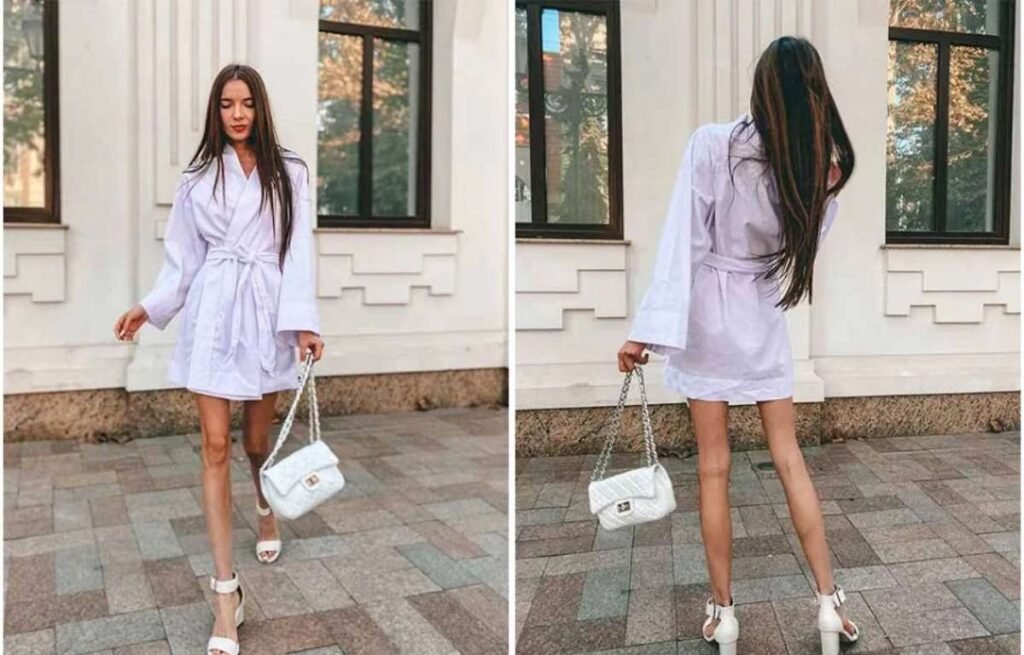
Kimono Dress: Effortless Elegance with Cultural Roots
The kimono dress blends traditional Japanese design with modern fashion, offering comfort, grace, and a relaxed silhouette.
Defined by wide sleeves, a wrapped front, and a tie-waist, the kimono dress drapes naturally over the body, creating an elegant yet laid-back look. It suits both casual and formal settings, depending on the fabric and styling.
Why is the Kimono Dress So Timeless and Flattering?
Kimono dresses work across cultures and body types thanks to their easy structure and adjustable waist.
Their loose fit, wide sleeves, and belted waist create a flowy silhouette that flatters without clinging to the body. The look is balanced, making it ideal for comfort without losing elegance.
What Makes the Kimono Dress So Universally Appealing?
Though inspired by traditional Japanese garments, the kimono dress has become a fashion staple worldwide. Here’s why:
1. Structure with Softness
The kimono dress offers structure through its wrapped design and sash belt, but without restricting movement. The relaxed sleeves and flowing hem create a soft visual line, giving the wearer freedom and ease.
- The waist belt allows full control over the shape.
- The V-neckline adds length to the neck and draws the eye vertically.
2. Inclusive Fit for All Body Types
Few dresses adapt as well to various shapes as the kimono dress:
- Pear-shaped: The wide sleeves balance the hips.
- Apple-shaped: The waist tie creates definition.
- Petite: The vertical wrap elongates the frame.
- Tall or plus-size: The soft drape flatters without overwhelming the figure.
3. Cultural Influence Meets Contemporary Style
The kimono dress maintains respectful nods to its origins—such as the T-shaped cut and obi-inspired sash—while adapting to modern tastes. It can be minimalistic or rich in prints, making it a canvas for artistic and cultural expression.
4. Ideal for Transitional Fashion
It’s a go-to piece for travel, resort wear, and lifestyle brands:
- Layerable: Can be worn over swimsuits, tank dresses, or pants.
- Seasonless: Works in lightweight cotton for summer or satin and velvet for cooler months.
- Dress or Robe: It can easily transition from a casual day look to evening wear with just a switch in accessories.
Kimono vs. Other Wrap Styles
| Feature | Kimono Dress | Classic Wrap Dress | Shirt Dress |
|---|---|---|---|
| Sleeves | Wide and loose | Fitted | Tailored or cuffed |
| Waist Definition | Adjustable tie-sash | Wrap-over with cinching | Often fixed waistband |
| Neckline | Deep V-wrap | V or crossover | Collared, buttoned |
| Silhouette | Soft and flowy | More form-fitting | Structured |
Best Fabrics for Kimono Dresses
Fabric choice shapes the entire feel of a kimono dress.
- Silk/Satin: Luxurious drape for evening or occasion wear.
- Rayon/Viscose: Soft and breathable, perfect for prints.
- Cotton/Linen: Casual, comfortable, and easy for summer.
- Chiffon/Georgette: Sheer, lightweight for layering or beach looks.
Styling Tips for Kimono Dresses
- Accessorize minimally to let the silhouette shine—opt for delicate earrings or a structured clutch.
- Define the waist with a wide sash or statement belt.
- Layer creatively—wear it open as a duster or robe for casual-chic style.
Cheongsam / Qipao
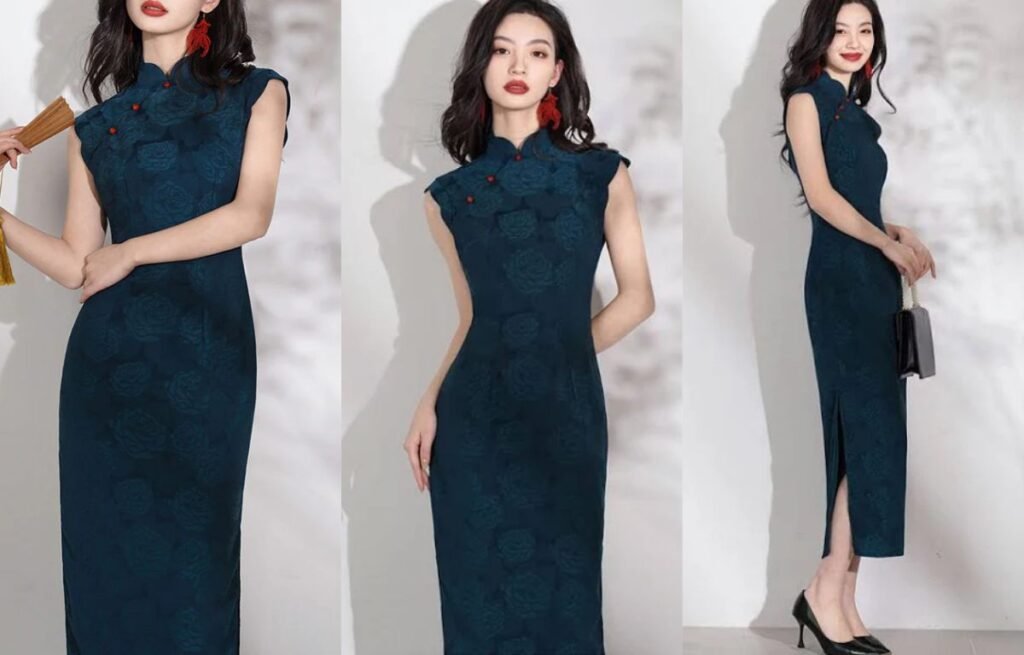
Cheongsam / Qipao: Elegance Rooted in Tradition
The Cheongsam, also known as Qipao, is a traditional Chinese dress that blends history, culture, and elegance into a sleek, body-skimming silhouette.
Characterized by its high collar, side slits, and fitted shape, the Qipao emphasizes grace and feminine curves while reflecting deep cultural roots. It’s both a fashion piece and a symbol of identity.
Why does the Qipao remain relevant in modern fashion?
The Qipao’s form is classic, yet its adaptability keeps it in style year after year.
Its clean silhouette and rich heritage make it suitable for formal occasions, cultural events, and modern reinterpretations in fashion collections. From weddings to runways, the Qipao continues to evolve.
Understanding the Power and Symbolism of the Qipao
The Qipao isn’t just a dress—it carries cultural meaning, historical weight, and design precision. Let’s explore why this style continues to resonate:
Origins and Cultural Significance
The modern Qipao emerged in 1920s Shanghai, when Chinese women began seeking a style that merged tradition with modern femininity. Originally derived from the loose-fitting robes of the Qing dynasty, the updated version was more fitted, refined, and cosmopolitan.
Over time, the Qipao became a symbol of elegance, poise, and Chinese femininity. Today, it’s still worn during weddings, Lunar New Year celebrations, and diplomatic events—often as a nod to cultural pride and identity.
Design Details That Define It
Key features of the Qipao include:
- High Mandarin Collar: Adds structure and elegance
- Asymmetrical Closure: Often with frog buttons or piping
- Fitted Silhouette: Emphasizes the waist and hips
- Side Slits: Allow ease of movement and a hint of allure
These elements work together to create a dress that is both conservative and subtly sensual.
Adaptability in Contemporary Fashion
Designers continue to reinvent the Qipao:
- Modern Fabrics: Lace, jersey, velvet, and even denim give the Qipao a new twist
- Shortened Hemlines: Mini and midi versions appeal to younger wearers
- Sleeveless and Cap-Sleeve Versions: Offer a modern, breathable update
- Fusion Styling: Qipaos paired with blazers or worn as tunics over trousers have entered the mainstream
This adaptability helps the Qipao remain relevant while still honoring its roots.
Ideal Occasions and Styling
- Weddings: Brides often choose red Qipaos for tea ceremonies or as a second wedding dress
- Formal Events: A silk Qipao with embroidery is perfect for galas or banquets
- Cultural Celebrations: Worn during Lunar New Year or heritage events
For styling, minimal jewelry and a sleek bun often enhance the Qipao’s clean lines. Heels or embroidered flats complete the look.
Qipao vs. Other Fitted Dresses
| Dress Type | Key Feature | Cultural Roots | Style Message |
|---|---|---|---|
| Qipao | High collar, side slits | Chinese | Elegant, traditional |
| Bodycon Dress | Stretch fabric, tight fit | Western | Sexy, modern |
| Sheath Dress | Clean, simple lines | Western | Sleek, formal |
Best Fabrics for Qipao Dresses
The choice of fabric defines both the elegance and comfort of the Qipao:
- Silk or Satin: Traditional and luxurious, often embroidered
- Velvet: Adds richness for winter or formal occasions
- Lace: Offers a romantic, modern look
- Stretch Blends: For body-hugging modern versions with more comfort
Corset Dress
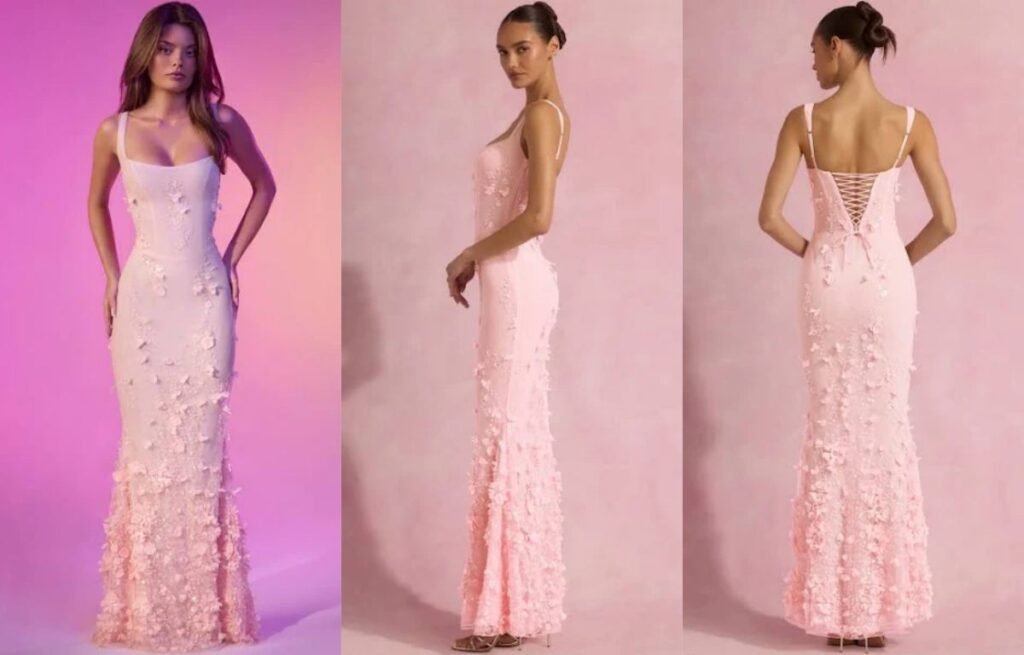
Corset Dress: Structure, Shape, and Confidence
The corset dress blends fashion with figure-enhancing structure. It combines a fitted bodice inspired by traditional corsets with a variety of skirt silhouettes.
Defined by its waist-cinching effect and visible boning or lace-up detailing, the corset dress sculpts the body and highlights the bust and waistline. It’s a bold yet elegant choice for formal events or trend-driven styling.
Why is the corset dress such a statement piece?
It does more than enhance curves—it creates a whole new silhouette.
The corset dress defines the waist, lifts the bust, and flatters the body, often blending historical influence with modern fashion. It adds drama and polish to both casual and occasionwear.
The Power and Design of Corset Dresses
Corset dresses are not just about aesthetics—they combine technical construction with stylistic intent. Here’s why this dress style continues to dominate runways and retail:
Shaping the Body
The defining feature of the corset dress is its shaping power. Built-in boning or paneling gently sculpts the torso, offering:
- A defined waistline
- Enhanced bust support
- Improved posture and structure
Depending on the level of support, corset dresses can feel light and flexible or fully structured like shapewear.
Fashion Meets Function
Unlike historical corsets, modern corset dresses prioritize comfort without sacrificing shape. Many styles use stretch panels, soft linings, or adjustable lacing to ensure ease of movement.
| Corset Type | Effect | Best For |
|---|---|---|
| Boned Bodice | Strong structure | Formal dresses |
| Soft Corsetry | Subtle shaping | Everyday wear |
| Lace-Up Styles | Adjustable, flexible fit | Trendy or edgy looks |
Versatile Styling
Corset dresses can lean romantic, sexy, vintage, or modern depending on the materials and silhouette. They come in many forms:
- Mini corset dress: Party-ready and bold
- Maxi corset gown: Perfect for galas or weddings
- Casual cotton corset dress: Great for daytime edge
- Denim or leather versions: Street style-approved
Fabric and Fit Matter
The corset element needs fabrics that hold structure. That’s why corset dresses are often made from:
- Satin or brocade: For elegance and sheen
- Cotton twill or denim: For casual yet firm shape
- Leather or faux leather: For a bold, modern look
- Mesh and lace overlays: To soften or add contrast
The skirt can be flowy, fitted, ruched, or layered—each option changing the overall effect.
Corset Dress vs. Other Body-Hugging Styles
| Dress Style | Structure Level | Waist Emphasis | Comfort Level |
|---|---|---|---|
| Corset Dress | High | Very defined | Moderate to high |
| Bodycon Dress | Medium | Natural shape | High (stretch fabrics) |
| Wrap Dress | Low | Adjustable tie | High |
Cut-out Dress
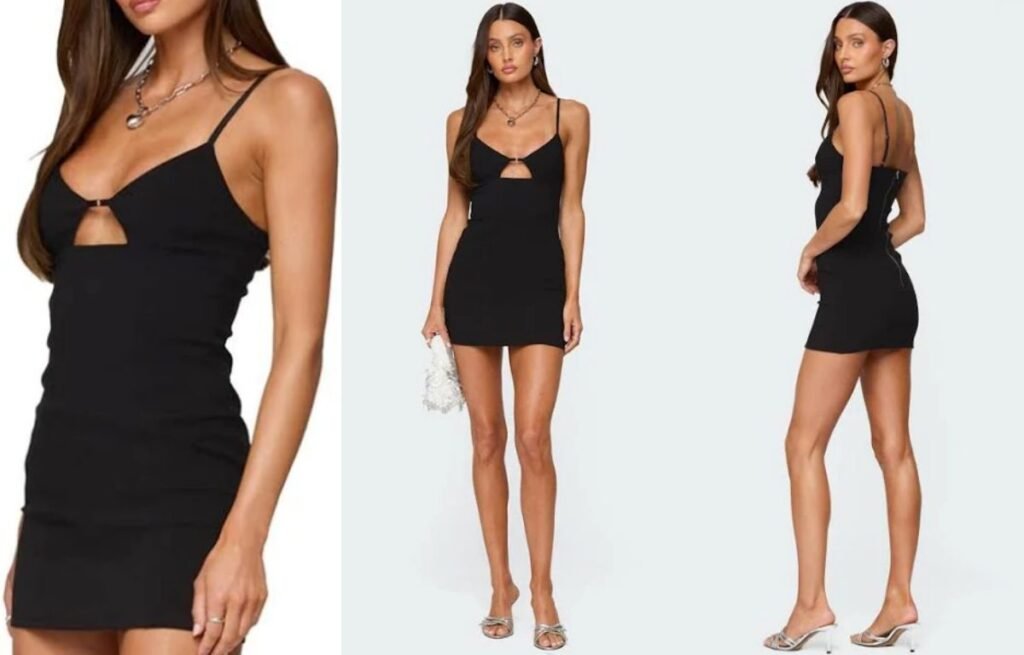
Cut-out Dress: Bold, Modern, and Body-Defining
The cut-out dress is a striking design that adds unexpected edge and sensuality through strategic openings in the fabric.
Defined by its exposed sections—often at the waist, back, shoulders, or chest—a cut-out dress balances allure with structure. It’s a favorite for confident, fashion-forward women who want to stand out.
Why is the cut-out dress trending again?
Cut-outs are more than a fashion trend—they reshape the silhouette and make bold statements.
A cut-out dress emphasizes body lines, draws attention to specific areas, and adds visual interest without extra embellishment. From red carpets to casual wear, its return shows how design can be both minimal and daring.
What makes cut-out dresses so impactful?
Though simple in concept, cut-out dresses involve careful design decisions. Placement, balance, and body type all influence how the final look feels.
Strategic Placement = Targeted Flattery
Cut-outs are most commonly placed at:
- Waist: Creates an hourglass illusion by highlighting curves
- Shoulders or sleeves: Adds dimension without being too revealing
- Back: Elegant and sensual, especially for eveningwear
- Under-bust or chest: Bold and eye-catching for statement looks
These openings draw the eye to specific features while offering contrast and structure. It’s not just about showing skin—it’s about shaping perception.
Balancing Exposure and Structure
Designers must balance negative space (cut-outs) with the dress’s overall structure. Too much exposure risks looking unpolished, while thoughtful placement creates harmony between skin and fabric.
For example:
- A bodycon cut-out dress uses tight fits and clean lines to maintain silhouette control.
- A flowy maxi cut-out dress pairs loose volume with a small waist cut-out to prevent overwhelming the body.
Body Type Considerations
- Hourglass: Waist cut-outs highlight curves
- Athletic: Side or back cut-outs add shape
- Petite: Vertical cut-outs elongate the frame
- Fuller figures: Shoulder or collarbone cut-outs bring focus upward
Cut-outs should never fight the body—they should work with it. That’s why smaller, precise cut-outs often feel more flattering than large or overly complex ones.
Fabric and Finish Matter
Cut-out dresses need structure and flexibility:
- Best fabrics: Ponte, stretch crepe, jersey, double-knit
- Avoid: Thin or overly loose materials—they can stretch, sag, or lose shape around the openings
- Reinforcements: Many cut-out areas include inner facings or bonded seams to maintain edge definition
Cut-Out Dress vs. Other Statement Dresses
| Feature | Cut-out Dress | Bodycon Dress | Backless Dress |
|---|---|---|---|
| Skin Exposure | Selective & sharp | Full body silhouette | Exposes back only |
| Focus Area | Waist, chest, back | Entire body line | Shoulder + back |
| Style Impact | Trendy, edgy | Sleek, bold | Elegant, sensual |
| Ideal Occasion | Party, club, event | Evening, date night | Formal, summer event |
Styling Tips for Cut-out Dresses
Keep it sleek and let the dress speak.
- Accessories: Minimalist jewelry to avoid clashing with the lines
- Undergarments: Seamless or adhesive styles—cut-outs leave no room for straps
- Layering: Avoid outerwear that covers the key design; try a cropped jacket or structured blazer instead
- Footwear: Strappy heels or statement boots for balance
Asymmetrical Dress
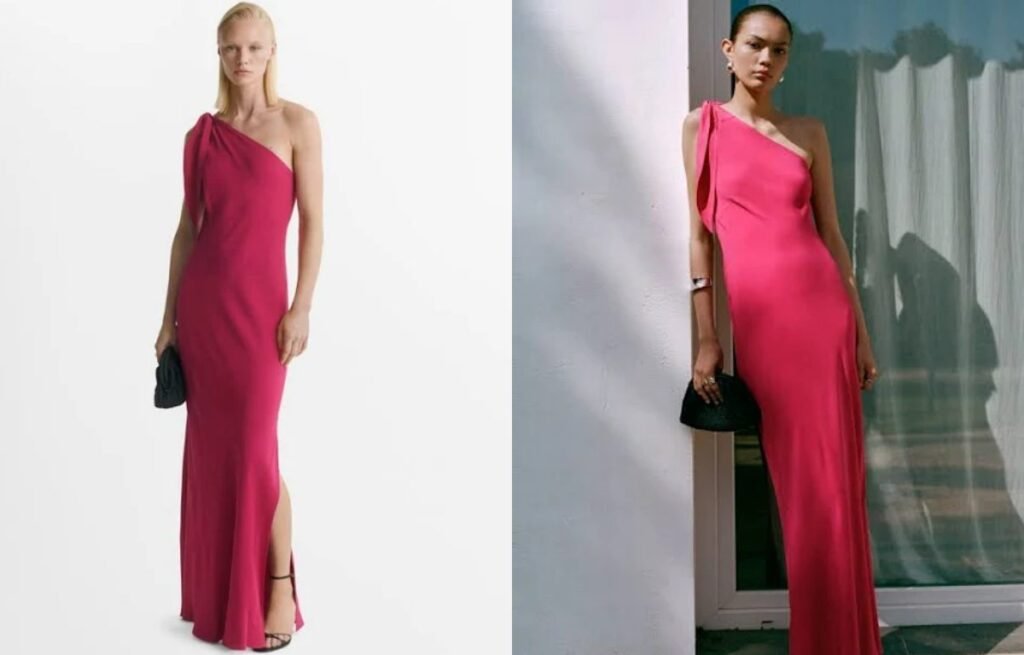
Asymmetrical Dress: Modern, Edgy, and Unexpected
The asymmetrical dress breaks away from traditional symmetry, offering a bold and modern design that stands out.
It features uneven lines in the hem, neckline, or sleeves—adding visual interest and movement. Often used in both casual and formal wear, this dress style creates a striking, fashion-forward silhouette.
What makes asymmetrical dresses so eye-catching?
Asymmetry draws the eye. It breaks the usual balance in clothing and creates visual movement.
These dresses play with proportion and lines, making them unique and flattering when designed thoughtfully. A high-low hem or one-shoulder neckline can highlight different parts of the body in a fresh way.
The Power of Imbalance in Fashion Design
Asymmetrical dresses use imbalance intentionally to reshape how we see the body. Instead of evenly matched sides, these garments create interest through irregular design choices.
Types of Asymmetry
- One-shoulder neckline: Highlights the upper body and collarbone.
- Asymmetrical hemline: Adds motion and edge, elongates the legs.
- Diagonal draping: Guides the eye across the body, creating shape.
- Mixed lengths or layered panels: Adds depth and dimension.
Each of these types serves a visual purpose—not just for aesthetic, but also for body contouring.
Flattering Effect on Body Shapes
- Petite frames: Diagonal lines create length and make the body appear taller.
- Pear-shaped bodies: Asymmetrical necklines draw attention upward.
- Curvy silhouettes: Off-balance elements like one-shoulder designs emphasize natural curves without bulk.
- Athletic builds: These styles add softness and visual curves.
Fabric Choice Matters
The success of asymmetry depends heavily on fabric behavior:
- Flowy fabrics like chiffon and silk create natural movement.
- Structured fabrics like crepe or taffeta hold bold angles and sharp lines.
- Stretch blends allow body-hugging asymmetrical cuts to remain comfortable.
Designers must ensure that the fabric enhances the line—not distracts from it.
Design Considerations
- Balance in imbalance: If one area is bold (e.g., one sleeve or dramatic hem), the rest of the dress should stay minimal.
- Seam placement: Diagonal seams must contour the body well, especially in fitted styles.
- Layering: Some asymmetrical dresses can be layered over leggings or pants for a street-style look.
Asymmetrical vs. Symmetrical Dresses
| Feature | Asymmetrical Dress | Symmetrical Dress |
|---|---|---|
| Visual Effect | Dynamic, fashion-forward | Classic, balanced |
| Movement | Often flowing or structured | Uniform |
| Best For | Making a statement | Everyday, traditional looks |
| Styling Flexibility | High, especially in modern wear | Moderate |
How to Style an Asymmetrical Dress?
Because of its bold design, balance is key.
Pair with minimal accessories and sleek shoes. Let the structure of the dress do the talking. Hair up or to one side can enhance the asymmetrical lines.
Ideal for:
- Evening events: In satin or crepe
- Casual streetwear: In jersey or cotton blends
- Layered outfits: Over pants or with jackets for contrast
Ruffle Dress
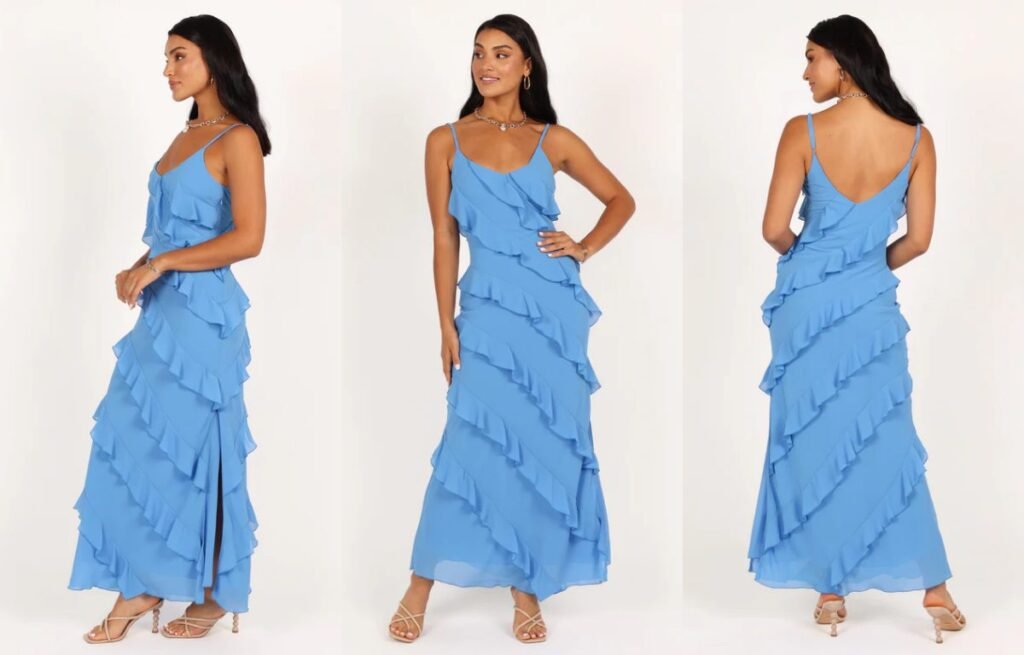
Ruffle Dress: Feminine Movement in Every Layer
The ruffle dress brings volume, softness, and visual interest to any silhouette.
A ruffle dress features decorative fabric frills, often placed along hemlines, sleeves, or bodices, to add motion and texture. It’s playful yet romantic, ideal for adding flair to both casual and formal styles.
Why is the ruffle dress so versatile and eye-catching?
Ruffles can change the mood of a dress—from soft and romantic to bold and dramatic.
They enhance movement, add volume, and draw attention to key design areas like the neckline, waist, or hem. Whether subtle or exaggerated, ruffles create a sense of energy in the outfit.
Understanding the Appeal and Function of Ruffles
Ruffles are not just decoration. They’re a strategic design element with both visual and structural impact.
1. Volume and Body Shaping
Ruffles can visually reshape the silhouette:
- At the neckline or sleeves: They add balance for women with narrow shoulders.
- At the hem: They add swing and flow without bulk.
- At the waist or hips: They create the illusion of curves or highlight the natural waistline.
Well-placed ruffles enhance or soften proportions, depending on the desired effect.
2. Movement and Motion
Unlike flat designs, ruffles add movement. When the wearer walks or turns, the ruffles flutter and sway, making the dress more dynamic and visually engaging. This effect works especially well in lightweight fabrics like chiffon or rayon.
3. Mood and Style
Ruffles can suggest different moods:
- Soft, small ruffles = romantic, vintage-inspired
- Bold, oversized ruffles = dramatic, fashion-forward
- Layered ruffles = youthful, boho, or Latin-inspired
Designers often use ruffles to express emotion or mood within a collection. For example, a tiered ruffle maxi dress feels carefree, while an off-shoulder ruffle gown can feel dramatic and powerful.
4. Ruffle Placement Strategy
Strategic placement affects balance and visual weight:
| Placement Area | Effect | Style Use |
|---|---|---|
| Sleeves | Adds width and drama | Ideal for balancing narrow frames |
| Bodice | Adds softness to the chest | Great for romantic looks |
| Waistline | Creates curves or definition | Helps shape straight figures |
| Skirt/Hem | Adds movement and flow | Common in boho or beach styles |
5. Ruffles in Design History
Historically, ruffles have been a recurring element across eras—from Rococo extravagance to ‘70s bohemian and modern runway styles. They’ve always reflected femininity, status, or artistic flair.
Today, designers use ruffles more freely—mixing them with minimalism or tailoring to add contrast and depth to a look.
Best Fabrics for Ruffle Dresses
The fabric must support the movement and shape of the ruffles.
- Chiffon/Georgette: Light and flowy, perfect for soft, layered ruffles.
- Cotton Voile: Crisp, breathable, great for summer dresses.
- Organza/Tulle: Adds volume for dramatic designs.
- Rayon/Viscose: Drapes well, moves with the body naturally.
Styling Tips for Ruffle Dresses
- Keep accessories minimal to let the ruffles stand out.
- Use belts if you want to define the waist.
- Footwear depends on the dress length—sandals for casual, heels for formal.
- Layer with structured jackets to contrast the softness of ruffles.
Tiered Dress
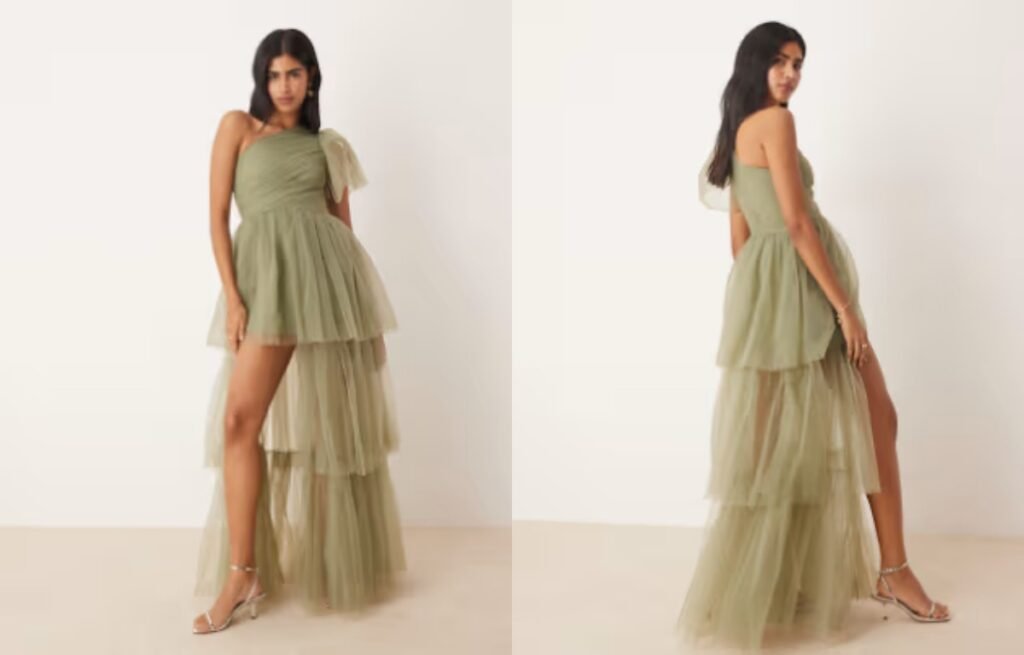
Tiered Dress: Volume, Movement, and Effortless Charm
The tiered dress is known for its layered construction, adding movement, volume, and visual interest without overwhelming the body.
This style features horizontal panels or layers—called tiers—stitched one over another, creating a cascading effect. It’s comfortable, flattering, and easy to style for casual, boho, or even formal settings.
Why do tiered dresses remain so popular?
The charm of the tiered dress lies in its flow and comfort.
It offers visual interest, natural volume, and body-skimming movement, making it ideal for many body shapes and styles. It’s effortless and eye-catching without trying too hard.
The Design Principles Behind Tiered Dresses
Though tiered dresses seem simple, the design relies on smart construction, proportion, and fabric selection to succeed. Here’s why they work so well:
Visual Balance and Soft Silhouette
Tiered designs soften the overall silhouette. The horizontal lines break the dress into sections, adding volume gradually rather than all at once. This layered effect helps create balance, especially for:
- Pear-shaped bodies: The upper tiers draw the eye upward.
- Rectangle shapes: The layers add curves and depth.
- Petite women: Shorter tiers create the illusion of height if scaled properly.
Each tier can be evenly spaced or vary in length to create more dynamic movement.
Movement and Comfort
The structure of tiered dresses is naturally loose-fitting, making them breathable and easy to move in. The layered design gives the dress life—each step causes a subtle sway or bounce.
Designers often use lightweight fabrics so that the tiers fall softly without adding bulk. Movement becomes a key visual feature of this silhouette, especially in:
- Maxi and midi styles: Ideal for summer or vacation collections.
- Sleeveless or puff-sleeve versions: Adds playfulness and contrast.
Fabric Choice Impacts Drape and Volume
Fabric defines how each tier behaves:
| Fabric Type | Resulting Effect |
|---|---|
| Cotton Voile | Crisp tiers, structured shape |
| Rayon/Viscose | Fluid drape, more relaxed |
| Chiffon | Light, airy, sheer layers |
| Linen | Casual, breathable texture |
Designers must balance fabric weight with the number of tiers—too many heavy layers can look bulky or feel restrictive.
Versatility Across Styles
The tiered dress fits multiple style categories:
- Boho: Paired with embroidery or lace, often in soft prints.
- Minimalist: Clean tiers, solid colors, no extra trim.
- Evening wear: Done in satin or tulle for dramatic layers.
- Street style: Tiered mini dresses with sneakers or boots.
Tiered vs. Other Voluminous Styles
| Style | Construction Approach | Look & Feel |
|---|---|---|
| Tiered Dress | Layered panels sewn together | Flowing, soft, playful |
| Ruffled Dress | Ruffles as decorative trims | Feminine, romantic |
| Pleated Dress | Folded fabric (not layered) | Structured, tailored |
How to Style a Tiered Dress?
- Shoes: Sandals for casual wear, heels for dressier events.
- Accessories: Keep them minimal to let the dress shine.
- Layering: Add a belt to define the waist or a jacket for contrast.
Denim Dress
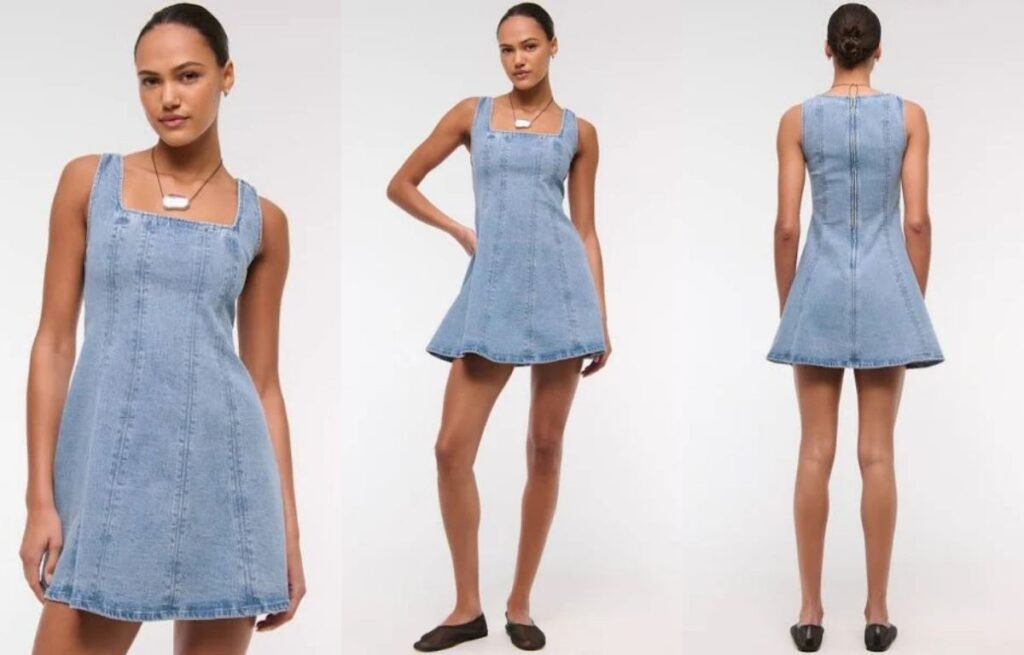
Denim Dress: The Casual Staple That Keeps Evolving
The denim dress blends casual comfort with timeless style, making it a go-to piece in everyday wardrobes.
Typically made from denim fabric, this dress can come in many forms—shirt dresses, A-line, overalls, or fitted silhouettes—offering both structure and versatility. It’s easy to style across seasons and always feels laid-back yet polished.
Why is the denim dress a long-standing favorite?
It’s durable, easy to wear, and never goes out of style.
Denim dresses offer a balance of structure and softness, making them perfect for casual wear while still feeling “put together.” They’re also incredibly adaptable to trends, from vintage to streetwear to minimalist.
Why the Denim Dress Works in Fashion and Function
The denim dress stands out not just because of its material, but because of its ability to evolve with fashion without losing relevance. Here’s a closer look:
Fabric with Character
Denim isn’t just sturdy—it has personality. Fades, washes, and stitching add depth to even the simplest silhouette. Over time, the fabric softens and molds to the wearer, making each denim dress more personal.
- Light-wash denim: Feels casual, summery, and youthful.
- Dark-wash denim: More refined, works for office-casual or transitional seasons.
- Distressed or raw denim: Adds edge and a fashion-forward vibe.
Universal Silhouettes
Denim dresses can be styled to flatter every body type. Common cuts include:
- Shirt Dress: Button-up style that works on all shapes. Belted for definition.
- A-Line: Feminine and flattering with a structured look.
- Bodycon: Adds edge, especially in stretch denim.
- Overall/Apron Style: Playful, often layered with tees or knits.
These silhouettes make the denim dress suitable for different lifestyles—from moms on-the-go to creative professionals to Gen Z shoppers who love ‘90s aesthetics.
Seasonless Style
Denim is seasonless. In warmer months, a sleeveless or mini denim dress works well with sandals or sneakers. In fall and winter, you can layer it over a turtleneck and pair with boots or tights.
- Spring/Summer: Pair with espadrilles, canvas sneakers, or slides.
- Fall/Winter: Add boots, a coat, or layer with knits underneath.
Streetwear to Minimalism
The denim dress can go in many directions depending on styling:
- Boho: Add a leather belt, hat, and slouchy boots.
- Minimalist: Choose a clean-cut silhouette in raw denim, pair with loafers.
- Street Style: Opt for oversized or distressed versions with chunky sneakers or combat boots.
Denim Dress vs. Other Casual Dresses
| Style | Structure | Vibe | Best Use |
|---|---|---|---|
| Denim Dress | Medium to firm | Urban, effortless | Daily, travel |
| Cotton Dress | Soft, lightweight | Relaxed, airy | Summer, loungewear |
| Jersey Dress | Stretchy | Sporty, casual | Weekend, errands |
| Linen Dress | Crisp, breathable | Natural, chic | Hot weather |
Best Denim Types for Dresses
Different types of denim suit different dress styles:
- Stretch Denim: Best for bodycon or fitted shapes.
- Rigid Cotton Denim: Ideal for shirt dresses or A-line styles.
- Lightweight Denim (Chambray): Works for summer looks or ruffle styles.
- Recycled Denim: Sustainable and adds character with visible texture.
Sweater Dress
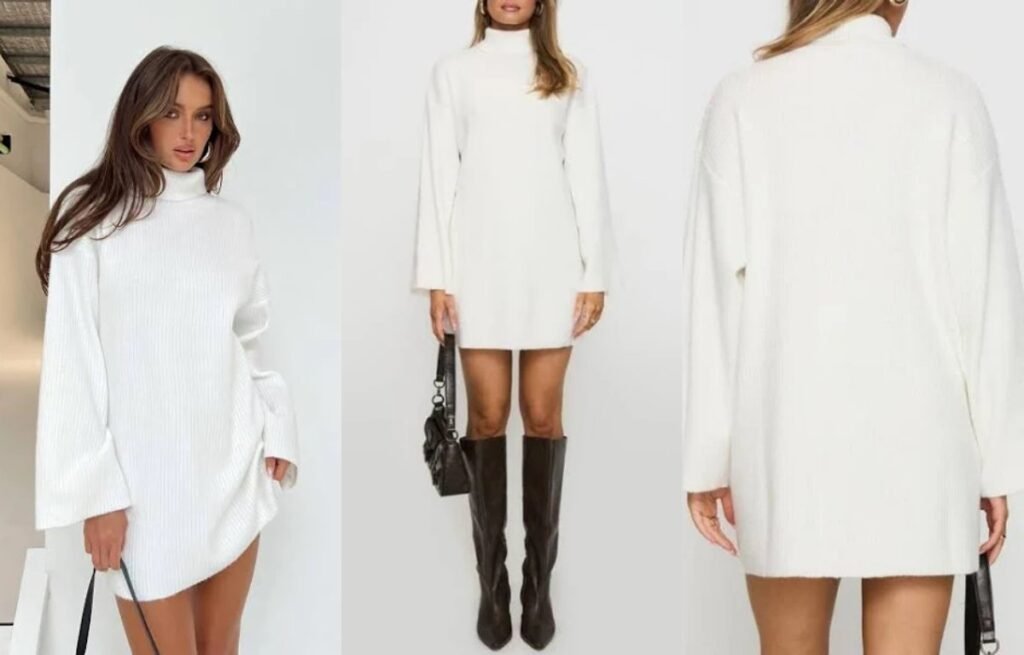
Sweater Dress: Comfort Meets Chic
The sweater dress blends the warmth of knitwear with the ease of a dress, making it a fall and winter wardrobe staple.
It’s a dress made from sweater-like materials—usually wool, cotton, or blends—designed to provide both comfort and effortless style. Whether fitted or oversized, it brings cozy elegance to any outfit.
Why is the Sweater Dress So Popular?
It offers the best of both worlds: comfort and style.
Sweater dresses are soft, warm, and easy to wear, yet they still create a put-together look without much effort. They’re ideal for cold seasons but adaptable enough for different styles and body types.
The Functional and Fashionable Appeal of the Sweater Dress
Though it may seem simple, the sweater dress is a highly strategic piece in a woman’s wardrobe. Here’s why it works so well:
All-Day Comfort with a Tailored Feel
Knit fabrics naturally stretch and move with the body, which means sweater dresses don’t restrict movement. Yet, depending on the knit density and fit, they can also define the body’s shape in subtle, flattering ways. A ribbed knit, for example, hugs the figure without feeling tight.
Versatility Across Silhouettes
Sweater dresses come in various shapes, and each serves a purpose:
- Bodycon sweater dresses: Ideal for highlighting curves with structure.
- Oversized sweater dresses: Offer a relaxed, slouchy vibe, great with boots or belts.
- Turtleneck styles: Add warmth and a polished, minimalist aesthetic.
- Wrap-style sweater dresses: Provide more waist definition and movement.
This range allows sweater dresses to move easily between casual, workwear, and even date-night looks.
Works with Layers and Accessories
Few dresses layer as easily as the sweater dress:
- Throw on a coat or leather jacket.
- Add leggings or tights for warmth.
- Use belts to change the silhouette.
- Pair with boots, sneakers, or heels depending on the mood.
Ideal for Transitional Seasons
Sweater dresses are perfect for fall and winter, but lightweight knits also work well in early spring. Fabrics like cotton knits or viscose blends make it breathable enough to wear in milder weather, especially in short-sleeve or midi versions.
Sweater Dress vs. Other Knit Dresses
| Feature | Sweater Dress | Knit Maxi Dress | Ribbed Midi Dress |
|---|---|---|---|
| Fit | Ranges from fitted to oversized | Usually loose and flowy | More structured, body-hugging |
| Styling Flexibility | Very high | Moderate | High |
| Seasonality | Fall/Winter/Spring | Spring/Summer | All-season |
| Key Benefit | Cozy and stylish | Relaxed and breezy | Slimming silhouette |
Best Fabrics for Sweater Dresses
The feel and structure of the dress depend heavily on the knit material:
- Wool and wool blends: Ideal for warmth and durability.
- Cotton knit: Softer and breathable, better for layering or transitional weather.
- Acrylic: Lightweight, affordable, and easy to care for.
- Viscose or modal blends: Soft and drapey with a polished finish.
Hoodie Dress
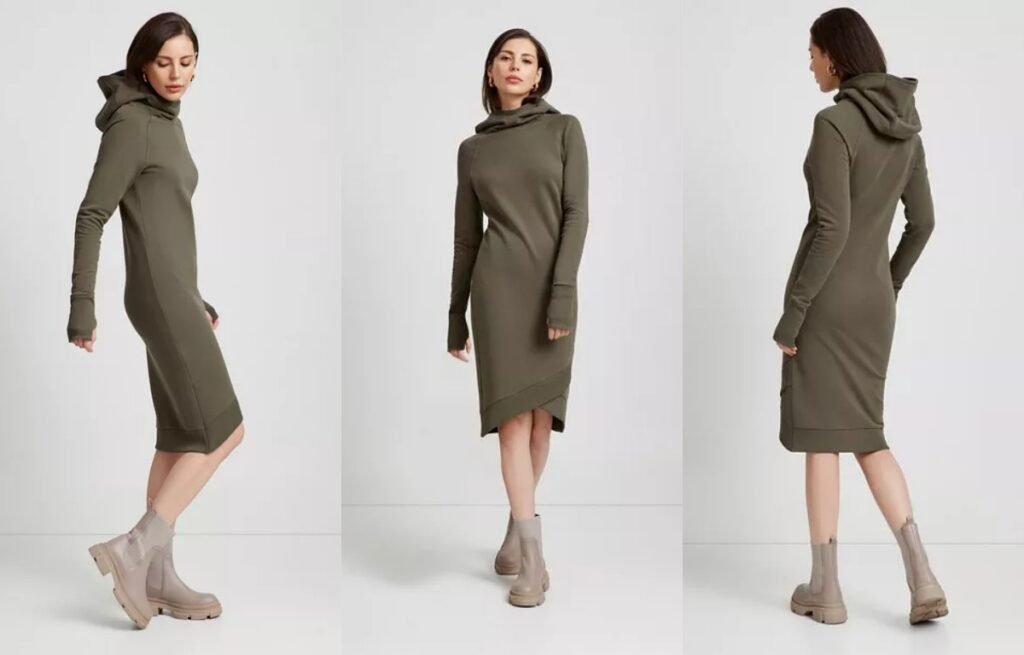
Hoodie Dress: Where Comfort Meets Street Style
The hoodie dress blends casual comfort with bold, urban aesthetics. It’s cozy, stylish, and effortlessly cool.
A hoodie dress is essentially a long hoodie designed as a dress, combining the relaxed fit of sportswear with the length and coverage of a dress. It often features drawstrings, front pockets, and soft, stretchy fabrics.
What makes the hoodie dress so wearable?
This style is loved for its comfort, but it’s also highly fashionable when styled right.
The hoodie dress is an all-in-one casual outfit that feels relaxed yet polished enough for off-duty looks. It’s a favorite for streetwear fans and anyone who values ease without compromising on style.
Why the Hoodie Dress Matters in Modern Fashion
The hoodie dress may seem like a simple casual item, but it reflects major shifts in fashion—especially the growing overlap between loungewear, streetwear, and womenswear.
A Symbol of Athleisure Evolution
The hoodie dress is a direct evolution of the athleisure trend. As more women seek fashion that’s comfortable yet expressive, the hoodie dress bridges both worlds. It’s sporty, but with styling, it easily becomes fashionable.
- Day-to-night adaptability: Paired with sneakers it’s sporty, but add boots and it becomes edgy.
- Fits multiple moods: It can look minimalist, oversized and androgynous, or shaped and feminine, depending on the cut.
Fits a Variety of Silhouettes
Hoodie dresses come in different cuts:
- Oversized: Offers a relaxed, youthful silhouette.
- Fitted: More polished, hugging the body slightly for a casual-chic look.
- Tunic-style: Works well with leggings or biker shorts, offering coverage without bulk.
This variety makes it suitable for many body types. Plus, the hoodie adds visual volume to the upper body, helping balance pear-shaped frames.
Material and Construction
Most hoodie dresses are made with cotton blends, fleece, or French terry—soft, breathable, and ideal for all-day wear. Some may include stretch for comfort or reinforced seams for durability.
| Fabric Type | Comfort Level | Season | Look |
|---|---|---|---|
| Cotton Fleece | High | Fall/Winter | Cozy and relaxed |
| French Terry | Medium | Spring/Fall | Lightweight and sporty |
| Jersey Knit | Light | Year-round | Sleek, drapey |
Fashion Meets Function
One major reason this style is sticking around? It’s wearable. It doesn’t require styling effort, yet always looks modern. With the rise of travel looks, airport outfits, and WFH wardrobes, hoodie dresses fit right in.
- Pockets: Functional and comfortable.
- Hood: Adds a streetwear edge and balances facial framing.
- Length: Can be mini, midi, or long—each changes the vibe entirely.
T-shirt Dress
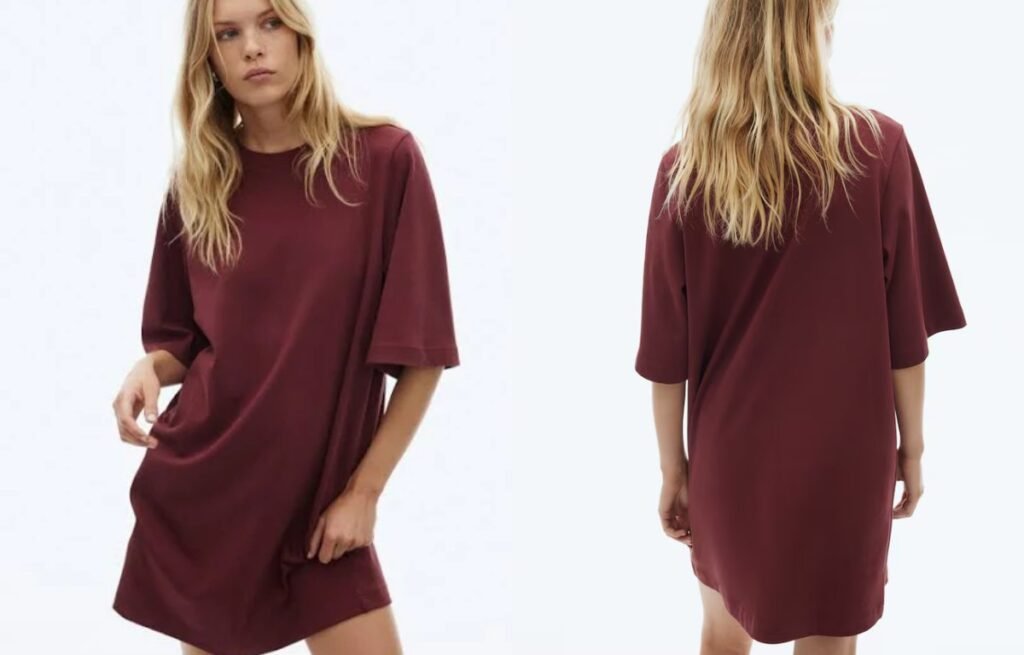
T-shirt Dress: The Ultimate Everyday Essential
The T-shirt dress is effortless, versatile, and loved for its comfort and simplicity.
A T-shirt dress features the classic shape of a tee—straight-cut, crew neck, short sleeves—but extends to dress length. It’s a go-to for casual, laid-back outfits and can easily be dressed up or down.
What makes the T-shirt dress a wardrobe must-have?
The beauty of the T-shirt dress lies in its simplicity. It fits all seasons, all body types, and all ages.
It offers a clean silhouette that works with nearly every style, from streetwear to minimalism. Whether oversized, fitted, or belted, the T-shirt dress adapts to whatever look you want.
Why the T-shirt Dress Works So Well
At first glance, the T-shirt dress looks basic. But its consistent popularity proves it’s far more than just a comfy outfit choice.
Universally Flattering Shape
T-shirt dresses often come in a straight or slightly A-line cut, which skims the body rather than hugging it. This makes it flattering for most shapes:
- Apple-shaped bodies: It drapes without clinging to the midsection.
- Pear-shaped bodies: Keeps volume on top and balances the silhouette.
- Athletic builds: Adds softness and casual appeal.
- Petite women: A mini T-shirt dress elongates the legs visually.
By changing the length or sleeve style, designers can target different demographics—from teens to working professionals.
Perfect Canvas for Styling
T-shirt dresses work as blank slates. You can dress them up or down based on accessories, footwear, or layering.
Styling options include:
- Add a belt: Define the waist and shift from relaxed to refined.
- Layer a blazer: Instantly creates a smart-casual look.
- Throw on sneakers: Perfect for weekend errands or travel.
- Pair with boots and a jacket: A fall-ready outfit in seconds.
You can even knot the hem or wear it with bike shorts for a more edgy, street-style vibe.
Fabric Flexibility
Most T-shirt dresses are made from breathable cotton jersey, but modern versions experiment with fabric:
| Fabric Type | Style Impact | Ideal For |
|---|---|---|
| Cotton Jersey | Soft, casual, breathable | Everyday wear, summer styles |
| Modal or Rayon | Drapey and lightweight | Minimalist or elevated looks |
| Ribbed Knit | Adds texture, hugs curves | Fitted or bodycon variations |
| French Terry | Cozy and slightly sporty | Transitional or lounge styles |
Related Articles
“Types of Dresses: The Ultimate Guide to 80+ Styles Every Woman Should Know(part 1)”
“Types of Dresses: The Ultimate Guide to 80+ Styles Every Woman Should Know(part 2)”


